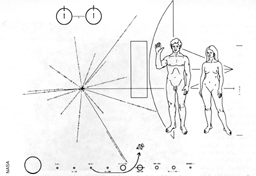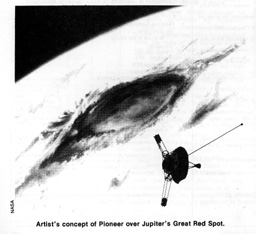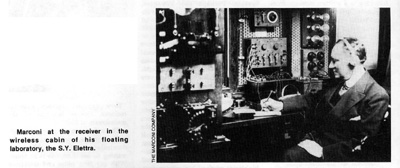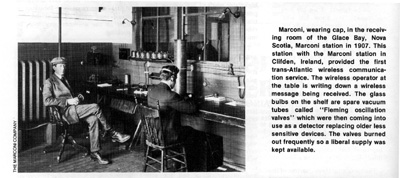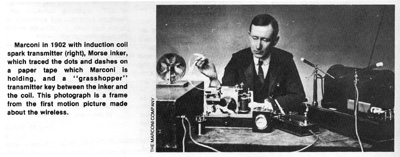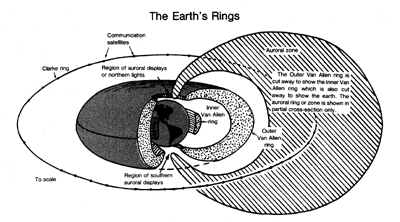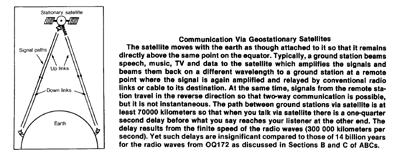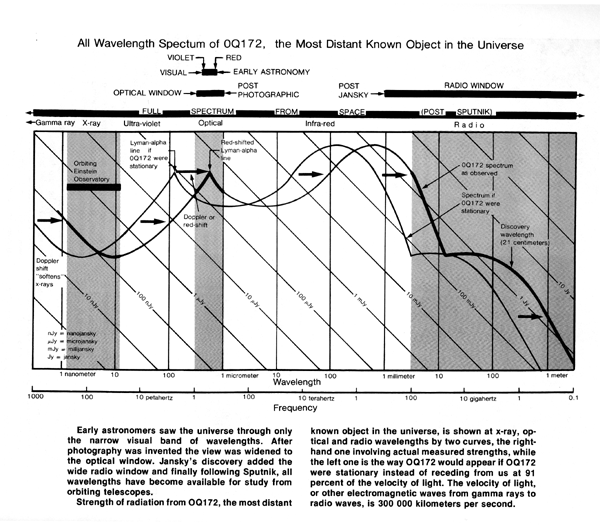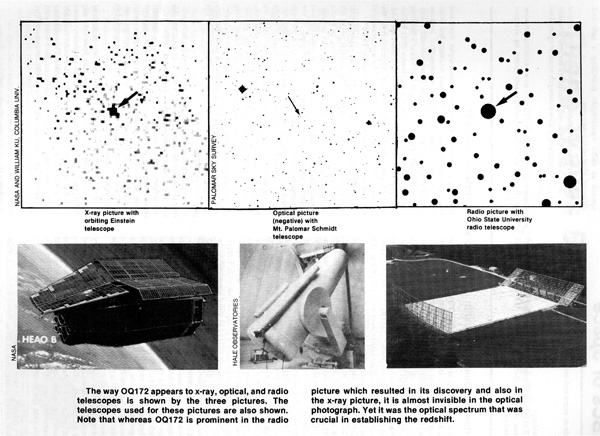![[NAAPO Logo]](../../Images/NAAPOsm.jpg)
North American AstroPhysical Observatory (NAAPO)
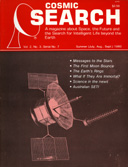
Cosmic Search: Issue 7
(Volume 2 Number 3; Summer (July, Aug., Sept.) 1980)
[All Articles & Miscellaneous Items]
|
Webpage Table of Contents (Bookmarks)
(Internal links to items in this webpage)
[Note. Use Back button (or <Alt>+<Left Arrow>) to get back to this Table of Contents after you have clicked on a link and viewed the article.]
Codes Used Below:
P: Starting page of article in magazine; A: Author(s); T: Title of article
|
Putting Our Best Signal Forward
By: Leonard David
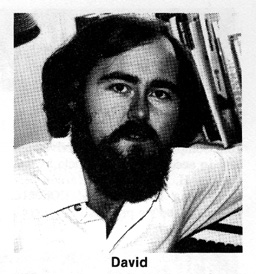 As the evidence builds that we are but part of a great galactic neighborhood, is it possible that we
can communicate with aliens next door?
As the evidence builds that we are but part of a great galactic neighborhood, is it possible that we
can communicate with aliens next door?
Some scientists warn that attempts to contact extraterrestrial intelligences should be restrained for fear of invasion by hostile beings. But in truth, messages from Earth are on their way outward, some sent by accident, others intentional. Satellites, space probes, radar telescopes have been used in an endeavor to convey our presence to other civilizations. Even President Carter had his hand at drafting a message to the stars — but more about this later.
And just how do you go about conversing with the cosmos? Try this:
Play a D
Now up a whole note
Now down a third
Now down an octave
Now up a perfect fifth
No this is not instruction from someone's piano teacher, but a method for communicating with extraterrestrial intelligence, by way of music. In his score for "Close Encounters of the Third Kind," conductor John Williams used this simple musical theme to establish a common language between the alien mother ship and an enraptured ground crew. The result was an explosion of musical exchanges so complex that a computer had to be used to keep up Earth's end of the conversation.
The thought of using the language of music for an alien encounter is not new. Dr. Lewis Thomas, author of "The Lives of a Cell: Notes of a Biology Watcher," suggests the use of a Bach concerto to announce our presence in the universe. Thomas believes that music would provide the extraterrestrials with knowledge of who and what we are. "I would vote for Bach," Thomas states, "all of Bach, streamed out into space, over and over again. We would be bragging of course, but it is surely excusable for us to put the best possible face on the beginning of such an acquaintance. We can tell the harder truths later."
It is probable alien intelligences already know the harder truths. The brilliant burst of light and energy from our first atomic bomb blast in 1945 produced a definite signal that intelligent (?) life on this planet had reached a certain level of technology. Those pulses of electromagnetic energy from initial atomic testing now stretch over 30 light years from Earth, crossing the paths of hundreds of stars, some of which may foster inhabited planets.
With the introduction of radio, television and powerful military radars, the Earth has evolved over several decades into an inadvertent beacon of human technology. To super-intelligent aliens we are most certainly "banging the village drums" in our part of the universe. One could imagine extraterrestrial scientists sifting through the buzz and static of the universe with sophisticated instruments, locating waves of information from our planet — a blend of I Love Lucy, the Lone
Ranger, Buck Rogers and Captain Video. Indeed, signals from Earth would relay a confusing picture of our species. From the clatter, aliens could easily surmize that "the natives are restless."
But this form of planetary babbling does not represent the serious efforts which have been undertaken to connect with the cosmos; to send signals of meaning, describing our species and extending an interstellar handshake and hello to our neighbors. As early as the 19th Century, methods were concocted to signal our presence to extraterrestrial intelligences. Although not carried out, consideration was given to shaping pine forests in Siberia to form a Pythagorean triangle. Others suggested the use of reflecting sunlight with mirrors or digging a twenty-mile trench in the Sahara, filling it with kerosene, and setting it ablaze.
|
Four Messages from Earth
Pioneer: The radiating lines at left represent the positions of 14 pulsars — cosmic sources of radio energy — arranged to indicate our Sun as the home star of the launching civilization. The "1-" symbols at the ends of the lines are binary numbers that represent the frequencies of these pulsars at the time of launch of Pioneer, relative to that of the hydrogen atom shown at the upper left with a "1 " unity symbol.
The hydrogen atom is thus used as a "universal clock" and the regular decrease in the frequencies of the pulsars will enable another civilization to determine the time that will have elapsed since Pioneer was launched. The hydrogen atom also is used as a "universal yardstick" for sizing the human figures and outline of the spacecraft, shown on the right. The hydrogen wavelength — 21 centimeters — multiplied by the binary number representing "8" shown next to the woman gives her height — 1.7 meters. The figures represent the type of creature that created Pioneer. The man's hand is raised in a gesture of good will. Across the bottom are the planets, ranging outward from the Sun, with the spacecraft's trajectory arching away from Earth, passing Mars, and swinging by Jupiter.
 Arecibo radio message (at left): The beamed message is composed of 1,679 binary pulses, represented by zeroes and ones. When the dots are arranged into 70 consecutive groups [sic; "70" should be "73"] of 23 characters, with "0" as a white square and each "1" as black, a visual message appears. Starting from the top right, the numbers one to ten are described in binary form. This provides a language which is used to translate the following message. The next symbols below display the atomic numbers of hydrogen, carbon, nitrogen, oxygen and phosphorus, the basic chemicals of life. Proceeding down further, the message uses the preceeding information to describe the building blocks of D.N.A. and in fact depicts the double-helix pattern of D.N.A. The core of the D.N.A. structure represents the number 4,000 million, roughly the number of characters which constitute the genetic code. Added up, these parts of the Arecibo message describe the chemical basis of Earth life.
Arecibo radio message (at left): The beamed message is composed of 1,679 binary pulses, represented by zeroes and ones. When the dots are arranged into 70 consecutive groups [sic; "70" should be "73"] of 23 characters, with "0" as a white square and each "1" as black, a visual message appears. Starting from the top right, the numbers one to ten are described in binary form. This provides a language which is used to translate the following message. The next symbols below display the atomic numbers of hydrogen, carbon, nitrogen, oxygen and phosphorus, the basic chemicals of life. Proceeding down further, the message uses the preceeding information to describe the building blocks of D.N.A. and in fact depicts the double-helix pattern of D.N.A. The core of the D.N.A. structure represents the number 4,000 million, roughly the number of characters which constitute the genetic code. Added up, these parts of the Arecibo message describe the chemical basis of Earth life.
Next is a cryptic representation of the human form, with a measure of height given to the right, and the approximate number of the human population on the left. This is followed by symbols relating the planets of our solar system, with the Earth displaced toward the human. The bottom three sections describe the Arecibo telescope itself, the message it has beamed and indicates the 300 meter size of the Arecibo installation.
The Arecibo Message was designed by Frank D. Drake and the staff of the National Astronomy & Ionosphere Center (NAIC). (The Arecibo Observatory is part of the NAIC which is operated by Cornell University under contract with the National Science Foundation.)
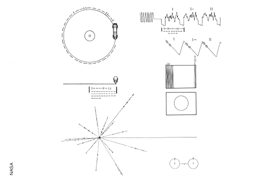 Voyager: In the upper left corner [in the drawing to the right] is a drawing of the phonograph record and the stylus carried with it. Written around it in binary arithmetic is the correct time of one rotation of the record, 3.6 seconds, expressed in time units of 0.70 billionths of a second. The drawing indicates that the record should be played from the outside in. Below this drawing is a sideview of the record and stylus, with a binary number giving the time to play one side of the record, about one hour. The information in the upper right portion of the record is designed to show how pictures are to be constructed from the recorded signals.
Voyager: In the upper left corner [in the drawing to the right] is a drawing of the phonograph record and the stylus carried with it. Written around it in binary arithmetic is the correct time of one rotation of the record, 3.6 seconds, expressed in time units of 0.70 billionths of a second. The drawing indicates that the record should be played from the outside in. Below this drawing is a sideview of the record and stylus, with a binary number giving the time to play one side of the record, about one hour. The information in the upper right portion of the record is designed to show how pictures are to be constructed from the recorded signals.
The upper right drawing [again in the drawing to the right] shows the typical wave form which occurs at the start of a picture. Picture lines 1 , 2, and 3 are noted in binary numbers, and the duration of one of the "picture lines," about 8 milliseconds, is noted. The drawing immediately below shows how these lines are to be drawn vertically, with a staggered interlace to give the correct picture rendition. Below this is a drawing of an entire picture raster, showing 512 vertical lines in a complete picture. Immediately
below this is a replica of the first picture on the record, allowing the recipients to verify that they are decoding the signals correctly. A circle is used to insure correct aspect ratio in reconstructing the picture.
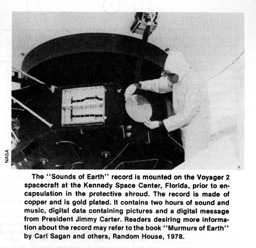
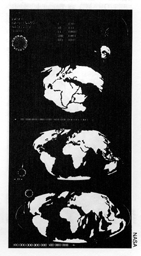 Lageos (at right): In the upper center, the message displays the simplest counting scheme, binary arithmetic, which uses only zeros and ones. The numbers one through 10 in binary notation are shown. At the upper right is a schematic drawing of the Earth in orbit around the Sun, an arrow indicates the direction of motion. The arrowhead points to the right, indicating the future. All arrows accompanying numbers represent "arrows of time." Under the Earth's orbit is the binary number one, denoting the period of time used on the plaque — one revolution of the Earth about the Sun, or one year.
Lageos (at right): In the upper center, the message displays the simplest counting scheme, binary arithmetic, which uses only zeros and ones. The numbers one through 10 in binary notation are shown. At the upper right is a schematic drawing of the Earth in orbit around the Sun, an arrow indicates the direction of motion. The arrowhead points to the right, indicating the future. All arrows accompanying numbers represent "arrows of time." Under the Earth's orbit is the binary number one, denoting the period of time used on the plaque — one revolution of the Earth about the Sun, or one year.
Beneath the first map, an arrowhead pointing left denotes the past and connects to a large binary number. In decimal notation this number is equivalent to about 268 million years ago, with the picture showing how many believe the Earth once appeared. The middle drawing represents the Earth as it appears today, and shows the Lageos being launched from California in a southerly direction. The zero with arrows pointed left and right indicates the present time. The final part of the Lageos message depicts the return of the satellite to Earth, with binary numbers and arrow indicating the approximate number of years following its launching. Geophyicists believe that, given the theory of continental drift, the Earth's land surfaces will have moved to locations as drawn on the final map.
|
A little known concept of cosmic conveyance to other planetary inhabitants was espoused by American rocket pioneer Robert Goddard in the 1920s. The imaginative engineer wrote to the Smithsonian Institution that, given the existence of intelligent beings on other worlds, a possible communications method " ... would consist in the sending of devices to the planets that would produce a succession of colors on falling through the atmosphere: the devices containing metal sheets stamped with geometrical figures; with the constellations emphasizing the Earth and the Moon..."
Today we find projects to announce our existence a little more complex, taking advantage of new space age technologies. Launched in 1972 and 1973, a couple of interplanetary robots named Pioneer 10 and 11 carried with them the first serious undertaking to contact alien civilizations. With their primary mission of investigating the planet Jupiter now complete (Pioneer 11 flew by Saturn in 1979), both carry a message from Earth, destined to leave our solar system and wander among other stars. With an exit velocity of around 11 kilometers per second, the Pioneers would not reach the nearest star for some 80,000 years, if in fact they were headed in that direction — which they are not.
Perhaps sometime in the future, an interstellar cruiser, noticing something off its bow, will pull alongside and haul a Pioneer onboard. Upon close examination of one section of the space-weathered exterior, strange but distinct scratches would be found. There, etched on a 15 by 22 centimeter gold-anodized aluminum plate, a message from some far-off planet, written in the cosmic language of all intelligences — science.
The Pioneer plaque, identical on both spacecraft, is designed to show inhabitants of other star systems when Pioneer was launched, from where, and by what kind of beings. Creator of the message, noted astronomer Dr. Carl Sagan, received assistance in its design by his artistic wife Linda Sagan and his radio astronomy colleague, Dr. Frank Drake. According to some estimates, eight average research scientists locked in a room all day should be able to decipher the meaning of the cosmic plaque.
As the old saying goes, "a picture is worth a thousand words," which is what the editor of the Los Angeles Times received from an irate reader when the newspaper ran a photograph of the plaque. "I must say I was shocked," protested the angry reader, "by the blatant display of both male and female sex organs on the front page of the Times." Continuing, the reader asserted "Isn't it enough that we must tolerate the bombardment of pornography through the media of film and smut magazines without our own space agency officials having found it necessary to spread this filth even beyond our own solar system?" Other public reaction complained that the man's upheld arm could be misconstrued as a form of Hitlerism, while religious organizations felt the message conveyed everything but God. From all the reaction stirred by the message, it would seem a follow-on Pioneer should be built to contain all the protests, providing a true picture of planet Earth's varying degrees of intellect!
Although current plans of searching for intelligent alien life have been geared to listening with radio telescopes, on November 16, 1974, a radio message was broadcast to the stars. On that day, the giant Arecibo radio telescope in Puerto Rico, transmitted a powerful three minute signal. The target? A globular cluster of stars in the constellation Hercules, 24,000 light-years away. By the time it reaches it destination, the beam will have spread itself to cover all 300,000 stars in the cluster, thus wasting none of its power — the first attempted interstellar broadcast practicing energy conservation!
As with the case of Pioneer, the team of Carl Sagan and Frank Drake was responsible for the signal's content. The beamed message would humble even Western Union. This "SETIGRAM", as Sagan labels it, describes the biochemistry of the human species, depicts our solar system, and contains a diagram of the Arecibo radio telescope. If there is a comparable radio telescope based somewhere in the Hercules star cluster, the message could be received, decoded, and a proper return signal generated. But the alien response wouldn't arrive here on Earth until about 50,000 A.D., which doesn't make it a snappy conversation!
Now circling nearly 4,000 miles above us, there exists another attempt to relay a message to advanced civilizations. Launched in May of 1976, a 60 centimeter, 400 kilogram sphere dubbed "Lageos," for Laser Geodynamic Satellite is now in Earth orbit.
This over-sized, golf-ball looking spacecraft contains no electronics, but is made up of hundreds of prism reflectors. By using a laser beam originating from Earth, and striking the prisms, scientists are studying continental drift, the Earth's rotation and wobble about its axis as well as movement along geologic faults, possibly aiding in earthquake prediction.
The stability of the Lageos orbit is so great that it will not be dragged in by the Earth's atmosphere or gravitation forces for an estimated 8 million years. Backed by the success of the Pioneer message, Carl Sagan was requested to design a similar plaque for Lageos. The result was two copies of a message, etched on stainless steel sheets, measuring just 10 by 18 centimeters. The plaques are contained inside the satellite, one on each end of a connecting bolt that holds the two
hemispheres of Lageos together. The plaques graphically and mathematically describe the mission of the spacecraft, when and from where it was launched. Three drawings show the position of the continents, 200 million years ago when they were grouped together, the way they are now, and where scientists anticipate them to drift in the next 10 million years.
Explains Sagan, "I have opted for the simplest possible representation which clearly conveys the existence and timing of continental drift and the connection of Lageos with continental drift. I also wanted to give considerable prominence to the remarkable geographical changes which have been brought about by plate tectonics."
In a very real sense, Lageos is an attempt to communicate with a future terrestrial super-intelligence — earthlings. Thanks to its long lifetime, Lageos is a time capsule in space from our civilization. Future Earth generations, changed by evolutionary biological processes, will find Lageos a footnote in Earth's space chronicles — a greeting card from the remote past.
The most recent attempt to chat with other star-folk involves the Voyagers 1 and 2, launched in August and September of 1977. The space probes are bound for a non-stop, scientific tour of the outer planets, Jupiter and Saturn, along with inspection of several of their respective moons. One Voyager might take a side-trip to Uranus as well. Both spacecraft will eventually drift out of the solar system and glide outward to other stars.
The Voyagers carry what represents a 20th Century, multi-media attempt to notify the universe of our existence and without commercial interruption. As with earlier efforts, Carl Sagan remains as the man-behind-the message. On this occasion however, Sagan assembled a committee of prominent scientists and educators to assist in developing the Voyager communique. Sagan originally had considered an advanced Pioneer plaque, but encouraged by members of the committee, a message with higher "information density" was agreed upon.
The final product was a 30 centimeter diameter, 16 and 2/3 r.p.m., two-hour long phonograph record, titled "Sounds of Earth." Developed in commemoration of the 100th anniversary of the invention of the phonograph by Edison, the record is a potpourri of items, including greetings from Earth people in different languages, samples of music from numerous cultures and eras, as well as natural sounds of surf, wind, thunder, birds, whales and other animals.
Each Voyager carries its phonograph record in an aluminum container, complete with porcelain cartridge, diamond stylus, and topped off with playing instructions. The actual recording begins with 115 pictures, electronically encoded within the grooves. Selected primarily by Frank Drake, photographs of human beings representing a variety of countries, landscapes of Earth, airplanes, varying aspects of human life, and views of our solar system, filter in and out of the collection. Quickly following is a written message from President Carter, a listing of congressional leaders (most likely an attempt to cultivate a future alien political vote), and a spoken greeting from U.N. Secretary General Kurt Waldheim. Waldheim's remarks are concise:
As the Secretary General of the United Nations, an organization of 147 member states who represent almost all of the human inhabitants of the planet Earth, I send greetings on behalf of the people of our planet. We step out of our solar system into the universe seeking only peace and friendship, to teach if we are called upon, to be taught if we are fortunate. We know full well that our planet and all its inhabitants are but a small part of the immense universe that surrounds us and it is with humility and hope that we take this step.
Next are greetings in 55 languages, including a small child speaking English, simply stating, "Hello from the children of planet Earth." The greetings are part of a "sound essay" which depicts Earth's evolution of biology and technology, represented by sounds from volcanoes, rain, ocean waves to animal noises, a human heartbeat and footsteps, a Saturn V liftoff, laughter, and even a kiss.
The remaining three quarters of the record is comprised of music, varying from Indian chants, flutes, and percussion pieces, to Bach, Beethoven, Stravinsky and a touch of Louis Armstrong and Chuck Berry for flavor. Apparently a hot debate took place regarding the selection of Chuck Berry's "Johnny B. Goode." Some members of the committee flatly stated there is no place in the universe for rock-and-roll. Younger members of the team protested, and later won, arguing that rock-and-roll is a product of diverse cultures, with the United States its birthplace.
As the Voyager recordings slip into the cosmic void, chances are good we will never hear how it is rated on a "galactic top-ten." One can only hope that who or whatever recovers the recording will have some kind of visual imaging and audio-sensing system. Perhaps the Voyagers, record and all, will wind up a meal for some alien life form, fond of aluminum and gold!
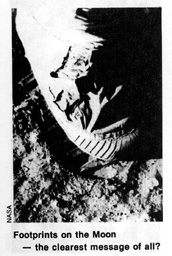 But our space exploration efforts have produced one additional message — the inhabitants of this planet have developed spaceflight. Artifacts of our civilization are strewn throughout the solar system; satellites now orbit the earth, Soviet and American probes bask on other planets, and vehicles are making their way to interstellar distances. More importantly, the Moon holds the clearest signal of all from Earth. If our planet were to vanish tomorrow, the Moon's vacuum and dusty surface have protected the technological highwater mark of our species: footprints. Preserved like that of the extinct dinosaur, Earthkind, the human robot, has left an imprint in the universe.
But our space exploration efforts have produced one additional message — the inhabitants of this planet have developed spaceflight. Artifacts of our civilization are strewn throughout the solar system; satellites now orbit the earth, Soviet and American probes bask on other planets, and vehicles are making their way to interstellar distances. More importantly, the Moon holds the clearest signal of all from Earth. If our planet were to vanish tomorrow, the Moon's vacuum and dusty surface have protected the technological highwater mark of our species: footprints. Preserved like that of the extinct dinosaur, Earthkind, the human robot, has left an imprint in the universe.
There have been scientists who suggest that phonograph records, plaques and etched messages to extraterrestrial intelligent life are mindless public relation gimmicks — standing in the way of "good" science. Others argue that the first contacts will come only through listening with upgraded radio telescopes. A few members of the scientific community point to newly developed lasers as a more reasonable way to conduct business. It is conceivable, and probable, that Earth is bombarded with daily messages from distant aliens, but their recognition and interpretation call for communication techniques yet to be developed or understood.
Our efforts to date may be as archaic as throwing cave paintings and ancient hieroglyphics into deep space. Perhaps they are as feeble an attempt as reflecting sunlight or setting the torch to gigantic bonfires. But it remains vitally important that we are attempting, however minimally, to reach out to other civilizations. To do less would be to put chains on our sense of inquiry and the exploration of the unknown. As Setiologist, Bernard Oliver, Vice President of Research and Development for Hewlett-Packard, recently stated, "How can we remain galactic recluses, forever ignorant of the mainstream of life?"
Through our inadvertent and planned messages, we have rung the doorbell of our galactic neighborhood, waiting to see if anyone is at home. With our first radio and television signals already passing locations in space that could be inhabited, the door to the universe may soon be
opening.
 Leonard David is Director of Space Data Resources and Information (SDR&I), a private consulting organization in Washington, D.C. He is currently involved in research for the Planning
Research Company, concerning the development of the solar power satellite concept.
Leonard David is Director of Space Data Resources and Information (SDR&I), a private consulting organization in Washington, D.C. He is currently involved in research for the Planning
Research Company, concerning the development of the solar power satellite concept.
He has been a frequent contributor to magazines, such as OMNI and Future Life, is Senior Editor for Aviation Space magazine, and editorial consultant for the American Institute for Aeronautics and Astronautics Student Journal.
Mr. David was formally Program Director for the Forum for the Advancement of Students in Science and Technology (FASST), organizing numerous conferences, symposia, and workshops on space exploration, including the search for extraterrestrial intelligence.
Statement by U.S. President Jimmy Carter
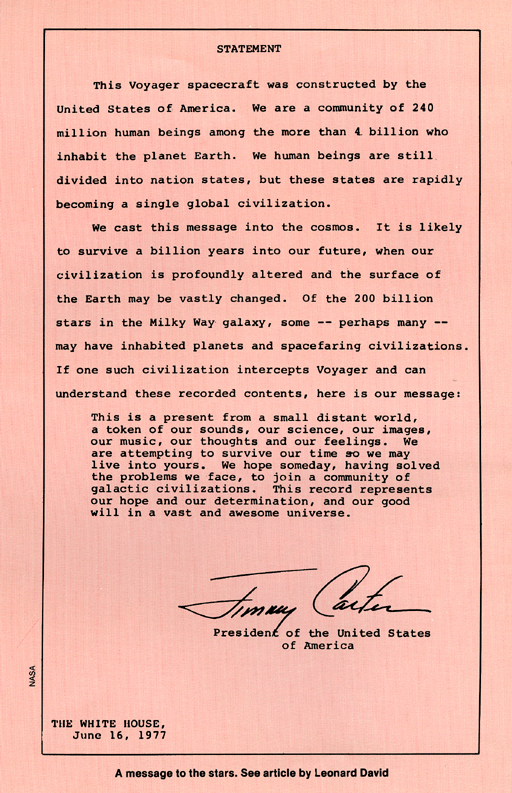
|
|
More Marconi
By: Editors
Some photographs from The Marconi Company in England arrived too late to accompany the article by Dr. George H. Brown on "Marconi" in the Spring 1980 issue of COSMIC SEARCH, so we present them here.
|
|
A Speculation on the Influence of Biological Immortality on SETI
By: Frank D. Drake
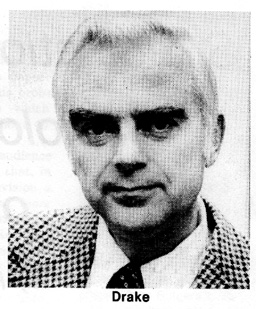 In designing a strategy for the radio search for extraterrestrial civilizations, we must make assumptions as to the sophistication and nature of the technology such civilizations might use to contact us. Such assumptions cannot be fool-proof, of course, in view of the fact that the creatures of other worlds may be far different from us and far more evolved biologically and sociologically. This could lead to radio transmissions which might seem to us remarkable or bizarre. So, no matter what our observational approach is, our philosophy and techniques may be "wrong", because of some technical "what ifs."
In designing a strategy for the radio search for extraterrestrial civilizations, we must make assumptions as to the sophistication and nature of the technology such civilizations might use to contact us. Such assumptions cannot be fool-proof, of course, in view of the fact that the creatures of other worlds may be far different from us and far more evolved biologically and sociologically. This could lead to radio transmissions which might seem to us remarkable or bizarre. So, no matter what our observational approach is, our philosophy and techniques may be "wrong", because of some technical "what ifs."
For instance, what if a civilization sends a radio signal our way only a small fraction of the time, say maybe a few hours a year? Then we must search every combination of direction in the sky and radio frequency many many times before hitting upon the brief interval when the signal is
actually arriving here. The search could be lengthened thousands of times by this "what if?" alone.
What if a method of coding is used which escapes the net set by our computer programs? We might well receive an information-bearing message and never realize it. At this time our radio telescopes look for modulation patterns of the sort that we use here on earth, such as TV signals. Yet, it is entirely reasonable that other types of modulations would be used. These might include changing the polarization of the radiation, say, from right-handed circular to left-handed circular polarization. There are many such possibilities and we simply cannot predict or search for all such combinations.
What if the "signal" is a myriad of weak signals? It is likely that most civilizations, like us, would broadcast very few strong signals, but a host of weaker ones. In such cases, the chances are small that any one of the strong signals are beamed our way. If our search patterns are geared to detect only these signals, then it is possible that we will not receive the other weaker ones simply because we have not used the correct techniques or built the proper instrumentation. In practice the detection of an ensemble of signals, each one by itself invisible, is possible but it requires a mathematical treatment of the observational data which is very demanding on computer systems.
To be sure, there will be many forms of intelligent life unimaginably different from ours. They will behave differently, and what is reasonable to them will be greatly different from our concepts of rationality. It could be that we cannot communicate with such creatures at all, even if we are able to detect them. There is no strategy we can now construct to cope with this plausible situation.
But what if they are immortal? This "what if" has come to trouble me a great deal.
Immortality is a different matter. Rather than rare, it may well be very common. By immortality, I mean the indefinite preservation, in a living being, of a growing and continouous set of memories of the experiences of the individual in which the memories reside. This could come about by the development of methods to eliminate the aging process in humans, or it could come through the discovery of means to repair indefinitely the damage caused by the aging process. It could come about through the development of the means to transfer the inventory of memories of an old brain into a young brain, perhaps even the brain of a clone, an exact copy of a person whose individuality is to be preserved. Death could still occur through the physical destruction of the human being.
Some of the steps seem not far in our future.
Just as nuclear energy and radio telescopes were inevitable steps in the technological development of our civilization, so it seems entirely reasonable to expect that in the biological realm time will bring us immortality, just as surely as it brought us a cure for poliomyelitis.
Although we can grasp some of the vast differences between our lives and those of immortal individuals, the totality of differences between a society of immortals and our own is surely beyond our comprehension. Immortals must have a fantastic obsession with safety, and every device and vehicle must be so constructed as to present no lethal hazard under any circumstance. I suspect that the use of aircraft for transportation, or indeed for any purpose, might be impossible, since a falling aircraft is a hazard to those on the ground as well as those aboard. But then, after all, who would be in a hurry anyway? Wars would probably no longer occur because no one would take the risk of fighting. One wonders how new births would be administered. Obviously after a relatively brief interval, the number of persons living would reach some optimal number which could not be exceeded. At that point, new births could be permitted only when someone died — an event which would happen rarely. So, someone would have to decide who should be authorized to contribute to the replacement of a human being.
A civilization of immortals would probably be extremely active in detecting and communicating with other intelligent civilizations for several reasons. First, such a civilization would soon use up the resources for amusement and adventure in its own limited planetary system and would want to share vicariously in the adventures of other civilizations.
More importantly, the reverence they would attach to the preservation of individual lives would drive these immortals to avoid physical threat from another planet, even over the cosmic time scale. This may seem a remote possibility, but they would have to be certain. They might in fact conceal themselves, and could prohibit transmission of radio signals detectable by other civilizations. This would not prohibit all signals, but only those so strong that they could be separated from the radio noise of the central star. But this would not stop civilizations with questionable intentions from seeking them out.
An immortal civilization's best assurance of safety would be to make other societies immortal like themselves, rather than risk hazardous military adventures. Thus, we could expect them to spread actively the secrets of their immortality among the young, technically developing civilizations. This hypothesis suggests that the numbers of their signals may well be greater than we imagine.
One practical consequence results from this somewhat muddy situation: no matter what the immortals' philosophy, they have all the time in the world. Immortality destroys the need to do anything in a hurry. And, when it comes to radio signaling, this can be used to enormous practical advantage. For you can signal reliably to all parts of the galaxy with little power and expense by concentrating that power in a very limited frequency band.
Any signals we can now detect require such a power that it is reasonable to assume that they are created by powerful radio transmitters whose output is concentrated into a narrow beam by a large radio telescope. This creates a high power level — but only in a small part of the sky. Such a transmission is an ineffective way to proceed if you don't know the location of other civilizations. The best way to contact civilizations whose direction is unknown is to transmit through a small antenna or radio telescope which will spray the power over a much larger fraction of the sky. The resultant signal strength in any given direction is very much less. But you can compensate for this by confining the transmitted power to a much smaller band of frequencies so that the power level in each unit frequency interval is very great. In this way one can compensate for the lack of beaming by the radio telescope by narrowing the frequency bandwidth of the signal. A small transmitter can create just as great a signal-to-noise ratio, or signal detectability, in a narrow band as would be created on a wider bandwidth by a gigantic transmitting facility.
This hypothesis, which leads to the assumption that we must detect a signal of narrow bandwidth, greatly increases the number of frequency channels which must be searched. More importantly, because of the laws of physics, we must assume under this hypothesis that information can be transferred only very slowly.
To give a numerical example, if the bandwidth of the transmission channel is only 1/1,000 cycle per second, a minimim of a 1,000 seconds is required to transmit any information at all. This may seem remarkably slow to us, but to the immortals it would seem the obvious way to go. It is entirely conceivable that the premier form of interstellar message consists of an extremely narrow-bandwidth transmission, perhaps only of 1/1,000 of 1/10,000 cycle per second wide, which changes in intensity or polarization, or in some other way, only in times of the order of hours.
There are natural limitations on the minimum bandwidth of interstellar signals, the result of clouds of interstellar gas containing a few electrons per cubic centimeter meandering across the lines of sight between civilizations. As these clouds cross the line of sight, the path of the radiation is slightly altered, with the result that the source appears to be moving toward or away from the receiver. Thus a tiny doppler effect is introduced. This changing doppler effect causes a drift in the signal frequency, limiting the minimum bandwidth. Numerically these drifts are terribly small, and they allow signal bandwidths of the order mentioned above.
All of the SETI searches so far have used bandwidths so great that their sensitivity to the signals of the immortals was probably only 1/1,000 of what is achievable with available equipment. Narrower bandwidths have not been used because the experimenters wanted to search some appreciable part of the universe within a short available time. With narrower bandwidths of the order of 1/1,000 cycle per second, the number of frequency channels which must be searched to cover a reasonable part of the radio spectrum is some ten trillion. No one has yet had the courage or the equipment to attack such a formidable number of possibilities.
I fear we have been making a dreadful mistake by not focusing all searches — including those to be accomplished by a system such as Cyclops — on the detection of the signals of the immortals. For it is the immortals we would most likely discover.
I have already given one reason why we should expect them to be abundant as message transmitters. But there is another independent argument which calls for the immortals' signals to be in the numerical majority.
It has been said that when we first discover other civilizations in space we will be the dumbest of them all. This is true, but more than that, we will probably be the only mortal civilization. Why is this?
We understand full well that our galaxy is a continuously evolving system producing new intelligent civilizations at nearly a constant rate. Indeed, the rate of production of new civilizations has been estimated at about one per year, including civilizations that remain mortal as well as those which achieve immortality. Mortal civilizations probably do not remain detectable forever, because their increasing technical sophistication enables them in time to cease the release of energy to space and thus to become undetectable. But some immortals must continue to transmit for cosmic time intervals, for the reasons given before. The number of either type of civilization at a given time is very simply the rate of appearance times the average longevity of civilizations. We think most intelligent civilizations become immortal, but even if this were not true and immortality were achieved only occasionally, the product of that rate times a nearly infinite lifetime will give a total number of immortals far greater than the population of all detectable mortal civilizations. So it is likely that immortals will dominate space. We should therefore concentrate our search on their signals, the narrow-band signals described above. We must pour some new wine into the old bottles of those who design searches for extraterrestrial intelligent signals. Otherwise, we could very well miss the strongest, and perhaps most provocative signals of all.
A portion of the above article by Frank Drake appeared in the June 1976 issue of the M.I.T. Technology Review. Reprinted by permission of Technology Review. Copyright 1976.
 Frank D. Drake is Goldwin Smith Professor of Astronomy at Cornell University and Director of the National Astronomy and Ionosphere Center which includes the Arecibo Observatory. His biographical sketch appeared in the premier issue of COSMIC SEARCH (January 1979) in connection with his article "A Reminiscence of Project Ozma". Dr. Drake is a member of the Editorial Board of COSMIC SEARCH.
Frank D. Drake is Goldwin Smith Professor of Astronomy at Cornell University and Director of the National Astronomy and Ionosphere Center which includes the Arecibo Observatory. His biographical sketch appeared in the premier issue of COSMIC SEARCH (January 1979) in connection with his article "A Reminiscence of Project Ozma". Dr. Drake is a member of the Editorial Board of COSMIC SEARCH.
|
|
In Review:
By: Editors
"NEW WORLDS, DISCOVERIES FROM OUR SOLAR SYSTEM"
By Wernher Von Braun and Frederick I. Ordway
Anchor Press/Doubleday 284 pages, $24.95
Would you like a large beautifully illustrated hard-bound "National Geographic" of the Solar System? Or a hard-bound volume with numerous well-captioned illustrations, many in color, and an easily readable text that tells the story of the evolution and present understanding of the Solar System? If you would, then "New Worlds, Discoveries from Our Solar System" is for you.
"New Worlds" opens with two chapters on the cosmogony of the Solar System. This is an account of what astronomers and astrophysicists believe to be the nature and sequence of events by which the Solar System evolved from the primordial chaos which grew out of the original big bang. Telescopic photographs and the many diagrams present a readily understandable picture of this process for the general reader. The sun itself, the interplanetary space, and the individual planets each have
a chapter to complete the story.
The sun, of course, is our most fascinating star. Thought of in ancient times as a symbol of perfection, the sun fell from such grace when sunspots were discovered. The development of our understanding of the sun from that discovery on is told with text and picture. The relevance of solar science to our daily lives is told in the closing paragraph of the sun's chapter, "The Sun may indeed be the key to our energy future but not necessarily in the form of the relatively simple gathering of its heat energy ... Rather, it could be the understanding of the physical processes involved in generating heat ... that will enable us to develop advanced sources of energy that we scarcely can dream of today. For in our thrust for knowledge about the Sun we are indeed probing into one of the enormous powerhouses of our galaxy."
The chapter, "Between the Planets" may surprise some readers. Interplanetary space is not as empty a vacuum as some might suppose. It contains great quantities of matter, dust, meteroidal material, plasmas, organic molecules and other debris permeated by "A Blizzard from the Sun" as the authors call the solar wind.
Each planetary chapter opens with an account of the early evolution of man's knowledge of the planet derived from earth-based measurements. Maps of the planets drawn from telescopic observations, spectroscopic chemical analysis, infra-red temperature measurements and the like led to many sophisticated speculations and questions about the nature of each planet. The advent of space probes made it possible to resolve many questions and raise new ones. Numerous photographs from space probes are included with captions sufficiently complete for a reader to browse through the pictures and get a good general idea of what has been learned. Along with the pictures are maps of planetary surfaces, diagrams of orbits and such features as the structure of magnetic and plasma fields, etc.
This book was written before the returns from Voyager I started coming in, so that neither the vulcanism on Jupiter's moon, Io, or the ring around Jupiter, is included. One would hope that a second edition will come out to include the results of the Voyager missions.
"New Worlds" would be a most welcome addition to any reader's science library. It would also be an excellent gift choice for a special occasion.
Robert H. Van Horn
Worthington, Ohio
"THE SEARCH FOR LIFE IN THE UNIVERSE"
by Donald Goldsmith and Tobias Owen
The Benjamin/Cummings Publishing Company, Inc., Menlo Park, CA. 415 pages, 1980.
This is a magnificent book which has more than just a little for everybody, and in fact can give a lot to anyone. Although it contains much of the material of a textbook, it is not a textbook. Instead of simply reciting the facts, the authors make it a point to emphasize what is deemed important, or what particular matters are the key to understanding say, the history of Venus. Of course this demands that the authors be extremely knowledgeable themselves, and that their subjective judgments be good, but so they are. Indeed, it is exactly this resultant reflection of the true puzzles, wonderments, and enigmas of modern science which makes the book particularly valuable and separates it in a good way from most of its predecessors.
The contents of the book include far more subjects than the title would suggest. To SETI people, this is not surprising, since it is well known that the abundance of life and the means of searching for it depend intimately on the basic make-up and history of the universe. This book, without trying, brings this home forcefully. There are sections on cosmology, the structure of galaxies, the interstellar medium (where do planets come from?), the evolution of stars (where do elements of life come from?), the chemical nature of life and how chemistry limits the forms of life which may exist. Then there are discussions of the nature of the planets of the solar system and a detailed discussion of the searches which have been carried out for life on Mars. Only on page 325 do we reach the question of extraterrestrial civilizations and the means by which we might detect them. The technical discussions here are more extensive and have more clarity than is usually found. Finally there is a sensible discussion of the phenomenon of UFO sightings and similar fringe subjects.
There is even a very sober and sensible discussion of a recent hot topic, the proposition that the absence of colonists on the earth from other stars is evidence that the extraterrestrials are absent, period. This subject has received a lot of hoopla recently, and the authors handle it adroitly, and, I believe, quite correctly.
This is a very readable book, full of facts and good illustrations. It can be read with enjoyment by anyone interested in SETI who has a reasonable education. The reader will gain enormously in the process, both in knowledge and an understanding of what is really important. At the same time, this book could be used as a textbook for college courses, but only by rather expert instructors, I think. There are many things to be inserted between the lines if one is to be thorough and complete (after all, it is not possible to put all of physics, chemistry, and astronomy in one book), and the competent instructor will have to have been down many scientific roads before.
Frank D. Drake
Cornell University
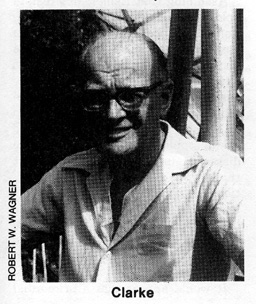 "FOUNTAINS OF PARADISE"
"FOUNTAINS OF PARADISE"
by Arthur C. Clarke
Ballantine Books (Random House), New York. 297 pages, 1978.
Sri Kanda — a holy mountain on the island paradise of Taprobane — is the unlikely focus of Clarke's novel of man and his future in the stars.
Clarke is once again at the forefront of science fact/science fiction by proposing an engineering feat that would be man's most daring and dangerous step to the stars. Vannevar Morgan, Earth engineer, has made the appropriate tedious calculations and has singled out Taprobane as Earth's endpoint of this steppingstone to the stars — a filamentary bridge connected to a synchronously-orbiting satellite 40,000 kilometers above the Earth.
The mountain of Sri Kanda, however, is ruled by a religious sect, that staunchly resists the intrusion of technology on its holy mountain. The monks' struggle to keep the mountain holy centers around King Kalidasa's reign, some two thousand years ago. Kalidasa made Sri Kanda a holy mountain, and now Vannevar Morgan attempts to snatch it out of their hands.
Vannevar Morgan is a true visionary — a man who sees beyond the political/religious strife of the times and views his bridge in space as man's best hope from being entrenched on Earth.
Clarke's story is further complicated by contact with an extraterrestrial intelligence (Starholme) so advanced that it refuses attempts to contact it and learn its origin.
FOUNTAINS OF PARADISE is the story of persistence and courage in the face of danger. Vannevar Morgan does not survive to see his steppingstone to the stars complete, but his life sets in motion forces that change Earth's destiny.
Mirjana Gearhart
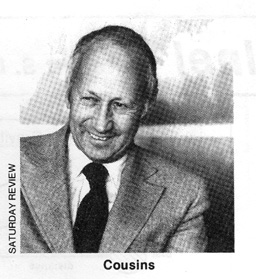
Cousins' Book in Spotlight
Norman Cousins' new book, "Anatomy of an Illness," has generated the greatest of interest among both doctors and lay persons. Cousins' amazing recovery, from what was believed to be a fatal illness, suggests to him that "the life-force may be the least understood force on earth." W.W. Norton, the publisher, reports the book is now in its 12th large printing.
Cousins is a member of the Editorial Board of COSMIC SEARCH. His article, "Rendezvous with Infinity," appeared in the premier issue of COSMIC SEARCH (January 1979).
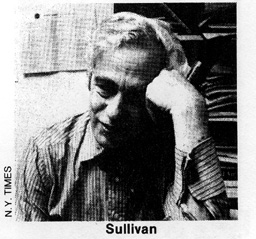
Sullivan Wins Awards
Walter Sullivan is the winner of the 1980 Dorothea Klumpke-Roberts Award of the Astronomical Society of the Pacific for his excellent articles explaining astronomical research clearly and reliably in non-technical terms. The award is presented each year for outstanding contributions to public understanding and appreciation of astronomy. Sullivan is the first journalist to receive the award.
Sullivan has also been awarded the Public Welfare Medal of the National Academy of Sciences for "his clarity of expression and extensive knowledge which have enabled millions of readers to understand the means and ends of scientific research." The award was presented on April 21 in Washington, D.C.
Sullivan is the author of the books, "We Are Not Alone" (1964), "Quest for a Continent" (1957), "Continents in Motion" (1974) and "Black Holes" (1979). Dr. Sullivan is a member of the Editorial Board of COSMIC SEARCH.
|
|
Letters:
By: Editors
Letters are always welcome but owing to the volume it is not possible to acknowledge all of them. Also due to space limitations we reserve the right where necessary to condense or edit the contents. Letters may be addressed to: Editorial Dept., COSMIC SEARCH, P.O. Box 293, Delaware, Ohio 43015.
I have thoroughly enjoyed COSMIC SEARCH as an efficient means of keeping tabs on a developing field. It makes a very good supplementary reference for exobiology courses.
Thomas Margrave Jr.
Dept. of Physics
University of Montana at Missoula
•
I am a subscriber of your beautiful magazine since its beginning and want you to know that COSMIC SEARCH isn't only a good journal for astronomers and other people who are interested in this topic. It can also be used as a valuable source material about SETI.
I am an educator at the Bochum Planetarium and have gotten many good ideas from the articles for my planetarium shows. COSMIC SEARCH is first class information for astronomy teachers. Keep going on!
Uwe Lemmer
Wuppertal, West Germany
•
I find COSMIC SEARCH to be a superb magazine. The articles are just right. In most magazines you either have to be a CBer to read them while in others you need to be an Einstein.
Joseph T. Pelham
Shelton, Connecticut
•
COSMIC SEARCH is possibly the most significant magazine in the English language.
J. Broderick
Physics Department
Virginia Polytechnic Institute and State University at Blacksburg
•
Keep up the good work. I cancelled another journal to continue my subscription to COSMIC SEARCH.
Howard Mehrling
Miami Springs, Florida
•
I have received the first 4 issues of COSMIC SEARCH and I have enjoyed reading them all very much. Enclosed is payment for a 2-year renewal subscription.
Dr. Samak Viravaidya
Bankok, Thailand
•
I am very interested in the cosmic searches going on nowadays so I was extremely delighted to find out about COSMIC SEARCH. Please start my 2-year subscription with the very first issue. Good luck in your search from all of us here.
Leonard Casha
Mosta, Malta
•
I want to commend you on the very fine quality of COSMIC SEARCH. I particularly like your inclusion of a glossary with each issue to help those unacquainted with the terminology through the "buzz words." You are a teacher par excellence.
Robert M. Sickels
Fort Lauderdale, Florida
•
I would like to congratulate you on COSMIC SEARCH. It's a nitty-gritty magazine that's a lot of fun to read. You're now getting in a wider range of material and presenting it in a reasonably good-looking format. And it's exciting.
Richard Berry
Editor, ASTRONOMY magazine
Milwaukee, Wisconsin
•
Thank you for the excellent "ABCs of Space" in the Winter 1980 issue. COSMIC SEARCH is a superb magazine.
Oscar Leon Cuellar
Consulting Radio Engineer
Denver, Colorado
•
I have very much enjoyed the past year's issues and am looking forward to the coming issues.
Also, I am interested in contacting any radio amateurs who are also interested in SETI for discussions, projects or whatever. It seems to me that ham radio operators may be able to contribute in various ways. Thanks again.
Scott Roleson
Santa Rosa, California
•
If you are truly cosmic, you already know that we are on the same wavelength. But just for the sake of politeness, let me tell you something about us:
News from Rural American Women is a news journal published bimonthly by Rural American Women, representing 25,000 women throughout rural America. The news journal aims to share essentially four kinds of information: news of interesting projects working in one part of rural America which might also work somewhere else; stories of experiences of rural women which tell us something important, encouraging, delightful or useful about each other; reports of developments in Washington that might be of interest to rural women — pending legislation, new sources of federal money, recently
available publications, guides, manuals; and perhaps most interesting to you, news of economic, social, political and demographic trends which suggest the shape of things to come — in rural
America, our nation and our world.
In a larger sense, we believe in the presence of universal energy, and we are trying to understand how we all can tap into that force and share it with each other. We are trying to communicate with each other in ways that are natural and vital and positive. And we believe that, to do all this, we must start with our individual selves, drawing on the inner strengths we all have, however suppressed they may be. And we as a society must go back where we started from — back to the
self-sufficient freedom and stability of rural America — and begin to see it in a new way.
News from Rural American Women is published six times a year. Subscriptions are $8 payable to Rural American Women,
1522 K St., NW, Suite 700, Washington, DC 20005.
Judith Gaines, Editor
News from Rural American Women
•
Enjoyed the Winter, 1980 issue — as usual. May I point out an error in Trudy Bell's delightful "The Great Analogy?"
Cosmotheoros, the title of Huygen's work, is not Latin, but Greek, and it does not mean "Theory of the Universe," but "Spectator of the Universe."
Arthur J. Morgan
New York, New York
•
Keep up the good work you guys.
Vera Buescher
Mountainview, California
•
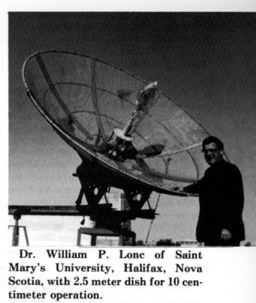 My sincere thanks for the enjoyment and knowledge that COSMIC SEARCH brings me. I only wish that I could contribute somehow to the SETI program. I am an Amateur Radio Operator and feel that the ham operators of the world could assist the effort in some way.
My sincere thanks for the enjoyment and knowledge that COSMIC SEARCH brings me. I only wish that I could contribute somehow to the SETI program. I am an Amateur Radio Operator and feel that the ham operators of the world could assist the effort in some way.
Perhaps your readers could suggest some project that calls for a great number of monitoring stations but not requiring the super sophisticated equipment usually associated with SETI. Listening to frequencies well in excess of 21 centimeters is not beyond the capability of most hams. In addition, many of us have the equipment to record large amounts of data onto hardcopy or magnetic medium for post processing.
Think about it. We would love to help!
J. Daniel Heather. NlDH
North Easton, Masachusetts
•
I enjoy COSMIC SEARCH very much. I would be interested to know if there is an active group on the amateur bands interested in SETI study, possibly a SETI net (network).
Gary W. Burrell, WB2SZM
Rochester, New York
We have heard that there is a SETI net run by Nick Marshall, W6OLO. It meets the first Sunday of every month on 14,280 MHz at 1900 UT. [sic; "14,280 MHz" should be "14.280 MHz"; (notation for the United States of America).] COSMIC SEARCH Co-Editor Bob Dixon, W8ERD, tries to check in occasionally and we encourage all interested radio amateurs to do so.
Ed.
•
I have just recently become interested in SETI and would like to thank all of the persons involved with COSMIC SEARCH for producing a publication of its caliber.
I have found the "ABCs of Space" sections of great interest primarily because my technical background is not directly related to radio astronomy or other subjects involved with space. Therefore, this section is helping me to understand more of the basic ideas and theories. I am presently attending Graduate School and plan to take as many courses involving related topics as possible.
I am sure many people, like myself, have a great interest in this topic and would someday like to help in this search but who are not yet technically qualified. In the meantime, to supplement the
ABCs section are there some books or articles you would recommend?
Let me encourage all of you at COSMIC SEARCH to keep up the good work. I personally feel that a major key to the survival of the human race may someday depend on the knowledge gained from space.
Whether there is intelligent life out there somewhere is an unanswerable question but we cannot stop trying and learning from our efforts.
I definitely plan to extend my subscription indefinitely.
Gene A. Wilson
Bell Laboratories
Murray Hill, New Jersey
RADIO ASTRONOMY by John Kraus (McGraw-Hill, 1966) covers the basics with worked examples and problem sets so it is well suited for self-study. —Eds.
•
May I express my appreciation for the way in which COSMIC SEARCH presents such lofty subjects in an entertaining and understandable way. There must be hundreds of other laymen like me who want to learn more about the search for intelligent life beyond the earth. The lead article in the Winter 1980 issue by Trudy E. Bell is an outstanding example of such an exposition.
Seth Harmon
Neptune City, New Jersey
•
COSMIC SEARCH has been a delight to many of us here in northern Colorado. I have told many of my friends about it.
Lucian Hunt Turner
Berthound, Colorado
•
I enjoy your magazine a great deal. It is extremely well written and very provocative.
G. Gregory White
Plymouth, Massachussets
•
A Happy First Birthday and best wishes for many happy returns. The enclosed donation is my birthday present.
In the table in SEnTInel for the Winter 1980 issue could the 1/4 and 1/10 meter telescope entries be typographical errors? The dimensions seem very small.
Erich W. Six
Iowa City, Iowa
We believe that the entries are correct as listed. The Russian radio astronomers are using very small and, hence, very wide beam antennas for rapid, low-sensitivity surveys looking for pulse signals. —Eds.
•
Congratulations for a marvelous scientific but lovable magazine! You open a new way of scientific and philosophical thinking for both lay and scientific people. Thanks a lot!
Mrs. Sevinic Buyukbese
Gasiantep, Turkey
•
I want to express my appreciation for a truly splendid magazine. I liked Richard Berendzen's magnificent editorial in the first issue, written with both deep insight and rare eloquence.
Professor Philip S. Riggs
Astronomy Department
Drake University
Des Moines, Iowa
•
I have been following your magazine with great interest! SETI is finally getting serious consideraton from NASA! Your interview with John Billingham (Winter 1980) was most gratifying! Keep
up the good work!
Could you give me any information on up-coming SETI conferences?
Michael Waggoner
Kingwood, Texas
You might check on the listings of College Courses on "Life in the Universe" for course offerings in your area (see page 38 of the Spring 1980 COSMIC SEARCH).
In recent issues COSMIC SEARCH has included reports of meetings in Mountain View, California, at the NASA-Ames Research Center (see report in the SEnTInel for the Winter, 1980, issue of COSMIC SEARCH); in Montreal (International Astronomical Union, see Winter 1980 issue); College Park, Maryland (see Spring 1980 issue) and Paris, France (see Spring, 1980 issue).
These were "one shot" conferences and not on any regular basis.
The only regularly scheduled SETI or CETI meetings of which we are aware are those held annually by the International Astronautical Federation. Many of the papers presented at the 1978 meeting in Dubrovnik, Yugoslavia, have been reported in the columns of SEnTlnel (see, for example, the Summer 1979 issue). The 1979 meeting in Munich, Germany, was reported in the Spring 1980 issue. The next meeting is scheduled to be held in Tokyo, Japan, September 21-28, 1980. (See COSMIC SEARCH for Winter 1980, page 33).
Eds.
•
COSMIC SEARCH is near the top of my magazine ratings. Keep up the fine production. All of the articles are well written and informative.
I know that Jesco von Puttkamer's article in the Fall 1979 issue involves a lot of assumptions and speculations but I think he underestimates substantially the number of stars in a 1000 light-year radius around the sun which are main-sequence stars. Texts like Abell's state that about 90 percent of the stars which have been classified in our galaxy are on the main-sequence compared to von Puttkamer's 33 percent. If our neighborhood is "typical," this would be a better estimate and would increase the number he arrives at for stars with at least one planet.
Robert Allen
Physics Department
University of Wisconsin at LaCrosse
An estimate should consider not just main-sequence stars but that sub-group of them which are most like the sun, since the sun is the only star we know of with planets. See ABCs of Space in the Summer 1979 issue.
Eds.
•
I enjoy COSMIC SEARCH very much.
Margaret McEven
Placitas, New Mexico
•
Keep up the good work.
David Smith
Phoenix, Arizona
•
I am delighted with COSMIC SEARCH.
Dwight E. Cooper
New Castle, Pennsylvania
•
Yes, there is something exceeding the speed of light!
Einstein has said that "we cannot exceed the speed of light." True, but for 40 years I have been watching the diameter of the universe increase many times faster than the speed of light. In a well-known reference book the diameter of our universe was given at 12 million light-years in 1941.
It has been steadily increasing so that by 1977 it had reached about 12 billion light-years and a current figure now is 20 billion light-years.
I have enjoyed the past issues of COSMIC SEARCH and look forward to each new issue.
Jerrold B. Winther
Professional Engineer
Kenosha, Wisconsin
Values for the size and/or age of the universe depend on the Hubble constant, a quantity whose value is a bit uncertain. See "Is the Universe 10 or 20 Billion Years Old?" in ABCs of Space in the Spring 1980 issue of COSMIC SEARCH.
Eds.
•
Although COSMIC SEARCH has had some excellent articles, I was somewhat indifferent to it up to now. However, when you said it is a kitchen table venture, that's good: I like to read COSMIC SEARCH at the kitchen table in the early hours.
An amateur forum on radio astronomy would be welcome. I had been looking for a source for audio cassette recordings of radio astronomy sounds for some time (see Bob's Electronics ad). I would also be interested in audio cassettes on the meetings such as reported by Jill Tarter and Virginia Trimble; something on the order of what the American Chemical Society does very effectively.
The article by Bruce Fleury is especially good, I think we are very naive about what is around us.
Arthur F. Greene, Jr.
Cleveland, Ohio
•
Your magazine is one of my favorites. Thank you for some superlative reading.
Donna Kellen
Phoenix, Arizona
•
I was very excited to receive my issues of your magazine. I enjoy it very much and wish you good luck for the future.
Michael R. Corder
Ames, Iowa
•
COSMIC SEARCH is a great magazine.
Andres D. Sanchez
Berkley, California
•
Your COSMIC SEARCH is the answer to my prayer. Thanks and best of luck in filling a void in understanding that is so badly needed.
James Morris
Columbus, Ohio
•
I like your magazine very much and am much interested in the search for life beyond the solar system.
William H.S. Cass
St. Charles, Missouri
•
I really enjoy COSMIC SEARCH. It must be quite a job to put it out.
Mary Hilbert
Marlborough, Connecticut
•
I shall certainly want to continue subscribing to COSMIC SEARCH as long as it is published.
Mary Gordon Ramsey
Bertram, Texas
•
The search for Extra-Terrestrial Intelligence is so important an endeavor that I believe in redesignating the year in which the first contact is made as the Year Zero.
Paul Simons
Sheboygan, Wisconson
•
Omission
In connection with Virginia Trimble's Symposium Report in the Spring 1980 issue of COSMIC SEARCH, we inadvertently omitted a note to the effect that the photographs accompanying the article were by the author.
[However, the above text of the Omission has been included at the end of the aforementioned article on this web browser version of COSMIC SEARCH.]
|
|
Australians Promote SETI
By: John Kraus
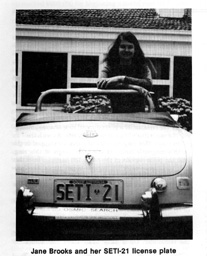 Two Australians, John Prytz of Canberra and Jane L. Brooks of Adelaide, have been campaigning for a formal Australian SETI project. They have authored a paper about their proposal which was to be circulated at the 50th Jubilee of the Australian-New Zealand Association for the Advancement of Science (ANZAAS) in Adelaide, May 12-16, 1980. At this same meeting, Dr. T.W. Cole, a radiophysicist of the Commonwealth Scientific and Industrial Research Organization (CSIRO), was to present a paper on SETI. It is reported that this would be the first time a SETI paper has been included in an ANZAAS program.
Two Australians, John Prytz of Canberra and Jane L. Brooks of Adelaide, have been campaigning for a formal Australian SETI project. They have authored a paper about their proposal which was to be circulated at the 50th Jubilee of the Australian-New Zealand Association for the Advancement of Science (ANZAAS) in Adelaide, May 12-16, 1980. At this same meeting, Dr. T.W. Cole, a radiophysicist of the Commonwealth Scientific and Industrial Research Organization (CSIRO), was to present a paper on SETI. It is reported that this would be the first time a SETI paper has been included in an ANZAAS program.
The paper by Prytz and Brooks first sets a background for the Search for Extra-Terrestrial Intelligence (SETI) with references to the Cocconi-Morrison article* and the OZMA experiments of Frank Drake.* (* The Cocconi-Morrison article and one by Frank Drake about OZMA were included in the premier issue of COSMIC SEARCH, (January 1979). The authors then point out that although Australia has excelled in radio astronomy, there has been no formal SETI program in Australia which "is a shame, for only Australia, of the nations located in the southern hemisphere, has the proper equipment, professional scientists and knowledge to survey the southern skies, to date a virgin SETI territory".
With these thoughts in mind, the authors launched "an intensive and personal multi-faceted lobbying effort" along 3 lines: scientific, political and via mass media to the public.
They were successful in obtaining publicity in Australian newspapers about SETI with "Letters to the Editor" because the idea was a novel one for many editors and hence deemed newsworthy. In part, the "Letter" stated:
"I suggest that Australia join in the American, Canadian and Russian efforts for SETI via the detection of artificial radio signals from extra-solar civilisations.
"A particular advantage of an Australian SETI program would be a survey of southern hemisphere stars not visible in the northern hemisphere, where current research is being carried out.
"Positive results, while not guaranteed, would be one of the most momentous occurrences in the civilisation of mankind. First contact with an alien race can happen only once and could well occur in the lifetime of most of us.
"There is no reason why Australia cannot be the country to do this. There can be no more outstanding philosophical question in modern science today than whether we are alone in the universe. No longer the exclusive realm of science fiction, SETI is an idea whose time has come of age."
They also found a number of Australian Ministers, Senators and Representatives receptive to the SETI idea and also interest by the CSIRO. But the CSIRO has financial constraints as indicated in their response:
"Three or four of our CSIRO scientists have been interested in the possibilities of SETI. If funds, technicians and equipment become available there is no doubt that some SETI work would go ahead. The difficult task is to convince Government circles that SETI or any science is of any use to Australia."
The authors conclude that "if past efforts for Australian SETI are any guide to the future, hard work and persistence will produce positive results" and although "an Australian program has not yet been intitiated, much progress towards that goal has been achieved, and the future is viewed as optimistically as the current economic climate realistically allows" because "the human adventure is just beginning."
Readers desiring more information about the Australian SETI program can write Mrs. Jane L. Brooks, 31 Avenue St., Millswood, South Australia 5034.
JK
The near term always takes precedence over the long term with our politicans.
The United States has only one significant advantage over other countries: the ability to develop entrepreneurial companies.
Robert Wilson
Chairman, Memorex
in "Electronic Engineering Times"
|
|
ABCs of Space
By: John Kraus
A. The Earth's Rings.
The rings of Saturn are its best known feature. For years the rings were thought to be unique. But now we know that both Uranus and Jupiter have rings.
The earth also has rings, at least four of them: two Van Allen rings, a Clarke ring and, extending farthest out, an auroral ring.
The earth's magnetism or magnetic field tends to trap many of the rapidly-moving charged particles (mostly electrons and protons) that flow out from the sun with the solar wind. These trapped particles form two doughnut-shaped belts or rings around the earth which were discovered by James Van Allen of the University of Iowa using particle counters carried into orbit early in 1958 on Explorer I, the first U.S. satellite. Although the rings are not visible, their presence is manifest in other ways: probes passing through them readily detect their charged particles.
The inner Van Allen ring is about 2500 kilometers and the outer Van Allen ring about 15000 kilometers above the earth's equator. Regions over the earth's poles are relatively free from these trapped particles. Since the particles are traveling rapidly, they can be damaging to space vehicles and dangerous to astronauts.
In 1945, while a radar officer in the Royal Air Force, Arthur C. Clarke published an article in Wireless World in which he proposed the use of artificial satellites and, in particular, those in a geostationary orbit, as a solution to the world communication problem. This was in the pre-Sputnik era and such a proposal then seemed highly visionary. Yet 12 years later Sputnik went up and only 6 years after that, or in 1963, the first successful geostationary satellite, Syncom 2, was put into orbit, and Clarke's proposal became a reality. Now there are many such satellites forming a Clarke ring around the earth at a height of 36000 kilometers above the equator with more satellites being added at frequent intervals.
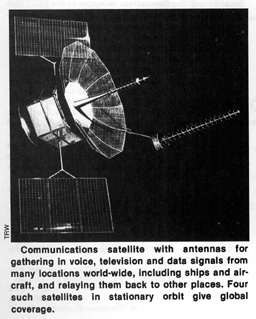
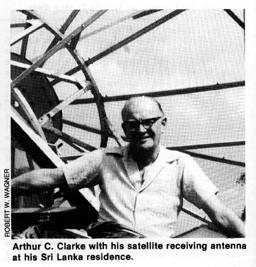
Farthest out, at heights of as much as 65000 kilometers above the equator, is a great auroral ring or zone enveloping the earth like a huge dune-buggy tire. As with the Van Allen rings, this ring consists of particles trapped in the earth's magnetic field. At the inner cusps of this ring, near the polar regions of the earth, the particles from this ring sometimes enter the earth's upper atmosphere producing the often-spectacular auroral displays.
Presently, there are 65 communication satellites in the Clarke ring. These satellites move with the earth as though attached to it so that from the earth each appears to remain stationary above a fixed point on the equator, hence the name earth- or geo-stationary satellite.
The U.S. owns two dozen of the satellites, Russia and Japan have about a dozen each and the rest of the world the remainder. On a daily basis these communication satellites handle millions of conversations and large amounts of data between points all around the world. However, not all of the communication is of an international type, many satellites being used for communication between two points in the same country. The U.S., Russia and Canada use satellites extensively for such internal communications.
In addition to the 65 communication satellites there are 15 more in the Clarke ring which are used for meteorological, scientific and experimental purposes. Two years after Syncom-2 was launched, a second communication satellite, Early Bird, was put up and live trans-Atlantic television transmission became possible. Gradually more satellites appeared in geostationary orbit but at a very slow rate until a few years ago when interest increased and many more began to go up. Now the demand for parking space in the Clarke ring and for radio channels for communication have increased dramatically and it is expected that in the next decade or so the number of satellites will increase many fold and also that many additional services will be offered.
Direct home-TV from Clarke satellites could become commonplace. The Communication Satellite Corporation, Comsat, has proposed 2 to 6 channels for U.S. TV viewers on a subscription basis in competition with the established TV networks and cable TV. However, Comsat's plans recently received a setback when Sears, Roebuck and Co. announced that it was terminating its negotiations with Comsat to develop the first U.S. direct satellite-to-home TV service. Sears indicated it was interested in such a service but only to the extent of installing and servicing the home units and not in becoming an investing partner with Comsat in the overall satellite venture.
In addition to the U.S. Comsat, there is an International Telecommunications Satellite Organization, or Intelsat, which has over 100 participating nations using geostationary satellites. While overall costs may be going up, the cost for a single one-way channel has decreased from $32000 15 years ago to $5000 today.
Personal communication with portable units between any two persons anywhere on earth may also become commonplace. Without using existing communication systems, a world traveler could talk via satellite directly with his home or office in Wichita, Kansas, with equal ease from the sidewalks of Unter den Linden, in Berlin, from an isolated oasis in the Sahara desert, from the desolate outback of Australia, or from the airport at Wichita, and, if the aircraft he rides in is suitably equipped, he can also do it while in flight over the Atlantic and Pacific Oceans.* (*Inside an aircraft the portable unit would be cut off by the shielding effect of the metal fuselage. However, a cable from the passenger seat to an external antenna could permit satisfactory communication.) If every one of the earth's 5 billion inhabitants were to carry such a unit, the traffic in communications and the need for satellites could become astronomic.
Eventually the Clarke ring could fill up with satellites until it might be desirable to link all of the satellites mechanically into a continuous rigid ring. But such density would require antennas with narrower beams for both the satellite and the earth stations. Presently satellites using the same frequency need to stay several degrees apart (or a couple thousand kilometers) in order that ground stations can separate them.
Also a great increase in the number of available channels will be required. Currently most communication satellites operate at wavelengths of 5 to 7 centimeters but some use shorter wavelengths of 2 to 3 centimeters. Even shorter wavelengths will, no doubt, see extensive use in the future because these shorter wavelengths or higher frequencies can accommodate more channels, however, attenuation by rain and absorbtion by water vapor may be a problem.
The Clarke ring is mankind's first astro-engineering structure on a grand scale. Although the earth did not come equipped with such a ring, we are constructing one. AND, it is being built as a commercial, money-making enterprise to provide mankind with an economical, reliable, world-wide communications system. The Clarke ring, 36000 kilometers above the equator, already provides services, employment and profits for millions of earthlings. With the Clarke ring, space has become a commercial enterprise.
Arthur C. Clarke, who now resides in Sri Lanka, is a member of the Editorial Board of COSMIC SEARCH.
Summary:
- Saturn, Uranus and Jupiter have rings and so does the earth.
- The earth has at least 4 rings. Three of them consist of doughnut-shaped zones containing charged particles trapped in the earth's magnetic field; these are the 2 Van Allen rings and the auroral ring.
- The fourth ring around the earth is the Clarke ring. Of recent origin, it is now beginning to fill up rapidly with geostationary satellites used for communication and other purposes.
- The Clarke ring is being built as a commercial enterprise to provide mankind with a world-wide communication system.
- The Clarke ring already provides services, employment and profits for millions of earthlings.
B. Toward a Full-Spectrum Astronomy and a New All-Encompassing View of the Cosmos.
Ancient shepherds, astronomers and other watchers of the sky viewed the heavens with unaided eye. This marvelous organ is responsive to a narrow band of wavelengths, or visible spectrum, embracing the entire rainbow of colors from violet, through blue, green, yellow and orange to red or from 400 to 700 nanometers wavelength. This is the nominal range of sensitivity of the human eye. Wavelengths less than 400 nanometers are called ultra-violet and wavelengths longer than 700 nanometers are called infra-red. Bees' eyes are sensitive to ultra-violet wavelengths almost as short as 300 nanometers and some snakes have receptors or pits sensitive to infra-red or heat wavelengths. A nanometer is one-millionth of a millimeter.
X-rays are shorter than ultra-violet and gamma rays shorter still. At the other end of the spectrum beyond the infra-red, wavelengths longer than about 1 millimeter are called radio waves.
Galileo's invention of the telescope made it possible to see fainter objects and greater detail but it did not extend the wavelength range beyond that of the human eye. However, with the advent of photography and other more recent techniques, astronomers extended their range of detection down to 300 nanometers in the ultra-violet and up to about 1000 nanometers in the infra-red.
But beyond that they could not go because the atmosphere is opaque to wavelengths shorter than 300 nanometers and longer than about 1000 nanometers. This range of atmospheric transparency is called the optical window* and celestial observations from the earth's surface are restricted to this part of the electromagnetic spectrum except for a few narrow windows in the 1 to 35 micrometer region and for a radio window. (*The limits of 300 and 1000 nanometers are somewhat arbitrary and have been rounded off for convenience; actually the long wavelength limit is more like 1100 nanometers. The nominal 400 and 700 nanometer values for the visual spectrum are also somewhat arbitrary; some authorities would place the long wavelength limit at 750 nanometers. In any case, the cut-off at the limits is not knife-edge sharp but rather gradual.)
It is significant that the wavelength range of human vision lies in the middle of the optical window, probably as a result of an evolutionary development of the eye to become most sensitive at those wavelengths for which the sun is brightest and the window most transparent.
About 1930 Karl Jansky discovered radio waves from our galaxy, opening a second "window" into space. This led, in the succeeding decades, to the development of radio astronomy with radiation from celestial objects being detected at the much longer wavelengths from 1 millimeter to some tens of meters. This wide range of wavelengths is called the radio window through which electromagnetic waves from space can reach the earth's surface. The window is cut off at the short wavelength end (about 1 millimeter) by the opacity of the atmosphere while the long wavelength end is cut off, not by the atmosphere, but by an ionized layer or blanket of charged particles called the ionosphere which envelops the earth at a height of several hundred kilometers.* (*The long wavelength limit due to the ionosphere is variable and is at longer wavelengths on the night side of the earth because it is shielded from the sun which is responsible for much of the ionization.)
Radio astronomy has had a revolutionary effect on our knowledge of the universe but it has been only a precursor of the further revolution in astronomy that has occurred in the years after Sputnik, in which telescopes for many wavelengths have been lofted into space above the earth's atmosphere and ionosphere. The view of these space telescopes is not limited to the optical and radio windows but is open to all wavelengths. (See "The Electromagnetic Spectrum" in ABCs for Spring 1980.)
Orbiting ultra-violet, x-ray and gamma ray telescopes have extended our knowledge of the universe to the shortest electromagnetic waves while infra-red telescopes and very long wavelength telescopes in space have stretched the cosmic spectrum to radio wavelengths of 1000s of meters.
Actually the earth radiates a strong noise from its Van Allen belts at wavelengths of 1000 to 3000 meters (see ABCs in the Winter 1980 COSMIC SEARCH) so being in earth orbit and above the ionosphere is not enough. Accordingly, the NASA Radio Astronomy Explorer-2 for wavelengths of 30 to 1200 meters was put into orbit around the moon so that during a part of each revolution it would be shielded by the moon from both the sun and the earth.
We have now entered an era of full-spectrum or all-wavelength astronomy in which observations of celestial objects can be made over the entire range of the electromagnetic spectrum. However, data on most celestial objects is still fragmentary and many more observations at more wavelengths will be required to provide complete spectra.
As an example, consider the quasar OQ172, the most distant known object in the universe. What we know about its spectrum is shown in the All-Wavelength Spectrum where the heavy line portions indicate the wavelengths for which actual measurements have been made. These are in the radio, optical, and x-ray regions. The lighter line portions are assumed extrapolations through the infra-red and ultra-violet regions where measurements have yet to be made.
Two spectral curves are shown, one based on observations, and, to its left, the spectrum as it would be if OQ172 were not moving with respect to us instead of receding from us at 91 percent of the velocity of light. The most prominent feature is the Lyman-alpha line of hydrogen which is Doppler or redshifted from the ultra-violet into the middle of the visible spectrum.
As discussed in the next section of ABCs, much has been learned about the nature of OQ172 but much more remains to be learned. Will infra-red and ultra-violet measurements confirm the extrapolations assumed in the diagram or will there be some surprises? As our all-wavelength astronomy matures and observations are made at more and more wavelengths we can hope to find out.
Summary:
- All of our early astronomical knowledge was limited to what could be discerned through the narrow optical window.
- In the decades after 1930 a much broader window was opened at radio wavelengths providing a new and different view of the universe.
- In the decades after Sputnik, observations from above the earth's atmosphere and ionosphere became possible and a full-spectrum or all-wavelength window opened on the universe.
- The observations of OQ172 give us an exciting preview of the new era of full-spectrum astronomy we are now entering.
| 1610 | Galilleo | First optical telescope |
| 1930 | Jansky | First radio telescope |
| 1970 | UHURU* | First orbiting x-ray telescope |
|
* Although rocket borne x-ray devices had obtained brief glimpses of the x-ray sky from above the earth's atmosphere as early as 1960, the first full-time survey of the x-ray sky began December 12, 1970. With the launching of UHURU (pronounced oo-hoo-ru) from a platform off the coast of Kenya. The launch date coincided with the 7th anniversary of Kenya's freedom, UHURU being the Swahili word for "freedom". UHURU was the first of a series of High Energy Astronomy Observatories (HEAO) built by the National Aeronautics and Space Administration for studying x-rays from space. |
C. How Is a Quasar's Redshift Determined and Its Distance Inferred?
In the preceding section we called OQ172 the most distant known object in the universe. How was this determined? The account reads like a detective story:
In 1967 during the Ohio State University 21-centimeter sky survey a strong radio source was discovered which was designated OQ172. The fact that it had not previously been detected in the longer wavelength surveys of other radio observatories suggested that OQ172 had an unusual spectrum. Additional measurements were then made at a Canadian radio observatory.
Next, a French astronomer found that the position of OQ172 in the sky coincided with a faint star-like object. This identification of a "star" (actually a quasar) with OQ172 was then confirmed when a very precise position for OQ172, as measured at an English radio observatory, was found to agree very closely with the "star's" location. With this information in hand, a team of astronomers at the Lick Observatory, California, used a newly developed electronic scanner to obtain an optical spectrum of OQ172 which established its redshift at a recordbreaking 3.53 or 353 percent. Later a wider spectrum was measured with the Palomar 5-meter telescope. Subsequently, a team of 23 radio astronomers in six countries measured a detailed radio spectrum and recently a group at Columbia University, New York, detected OQ172 at x-ray wavelengths using the orbiting Einstein Observatory (High Energy Astronomical Observatory-2) of the National Aeronautics
and Space Administration.
Now let's examine how the high redshift for OQ172 was determined and what this means. The Lick Observatory team found peaks of intensity in the optical spectrum which they related to emission from atoms of the elements of hydrogen and carbon in OQ172 but shifted to much longer wavelengths than these same atoms emit in a laboratory here on the earth. The shift is interpreted to mean that OQ172 is rapidly receding from us, the increase in wavelength being due to the Doppler effect.
More explicitly the Lick Observatory team found a very prominent peak at 554 nanometers and a weaker one at 702 nanometers. These wavelengths have the same ratio that certain hydrogen and carbon lines have in the laboratory where their wavelengths are 122 and 155 nanometers, respectively.* (*The redshift is equal to the difference of the shifted and unshifted wavelengths divided by the unshifted wavelength. Thus, we have (702 - 155)/155 = 3.53 or 353 percent.) Thus, the Lick team could conclude that the emission peaks were due to atoms of excited but un-ionized hydrogen (Lyman-alpha line) and triply-ionized carbon (three electrons missing) but both lines Doppler shifted to longer wavelengths because OQ172 was receding from us at the unprecedented velocity of 91 percent of the speed of light and was at a distance of nearly 14 billion light-years in a universe of 15 billion light-years radius. See accompanying Spectral-Line Redshift Diagram for Quasars. (For an explanation of the Doppler effect see ABCs Fall 1979, and for a discussion of the size of the universe see ABCs for Spring 1980.)
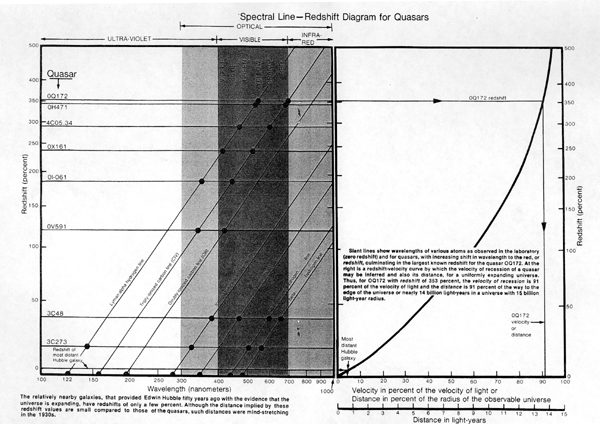
The 353 percent redshift for OQ172 is an experimental result which stands on its own. If the spectral peaks are actually due to atoms of hydrogen and carbon, as seems well established, the redshift value is not subject to interpretations or assumptions. However, the velocity and distance values are inferred results which depend on the assumption that OQ172 is receding from us in a universe which is expanding uniformly (with a certain Hubble constant* (*See ABCs for the last issue (Spring 1980)) following an initial Big Bang. The redshift might be interpreted in other ways, but the interpretation we have made is generally thought to be the most plausible.
Although the above discussion indicates the general procedure, it is greatly oversimplified and much more enters into the various steps. For example, the hydrogen and carbon lines of OQ172 are also found in other quasars of lesser redshift and this lends confidence that the analysis is correct.
The principal atomic emission lines used for determining the redshifts of quasars are shown in the diagram. All of the quasars listed were discovered with radio telescopes, then identified with an optical object (quasar) and finally an optical spectrum obtained with emission lines which could be identified unambiguously with atomic elements. The radio surveys acts as an arrow directing the attention to what might otherwise be regarded as very faint, ordinary stars.
As the redshift increases, the observed wavelength of the emission lines becomes longer so that lines normally in the visible (at zero redshift in an earth laboratory) move into the infra-red, while lines in the ultra-violet (notably the Lyman-alpha line) shift into the visible. The solid dots on the lines indicate that these particular lines were used in the redshift determination of a particular quasar. The half-circles (at zero redshift) indicate the wavelength of the lines for a stationary source, as in a laboratory on the earth. For smaller redshifts (under 50 percent) the lines of magnesium, neon and hydrogen (Balmer beta and gamma lines) were the keys to the redshift,* (*Recently, with an orbiting ultra-violet telescope, the Lyman-alpha line was found to be prominent in the spectrum of the low redshift quasar 3C273.) while at higher redshifts of 200 percent or more, a carbon line and the Lyman-alpha line of hydrogen were the keys. Note how the two dots on these lines for the quasar OI-061 at about 200 percent redshift move to the right or to longer wavelengths as the redshift increases, culminating in the values for the highest redshift quasars OQ172 and OH471. It is apparent that for a hypothetical quasar with a redshift of 500 percent these lines will be shifted entirely out of the visible spectrum.
When Professor Theodore Lyman first succeeded in observing the 122 nanometer line of hydrogen (now known as the Lyman-alpha line) in a Harvard physics laboratory in 1905, he could not have forseen that 7 decades later this line would be found in the spectrum of faint quasars but shifted from the ultra-violet into the visible and play a key role in determining their large redshift and enormous distance.
What can be said about the nature of the quasars, such as OQ172? Although a quasar is quasi-stellar in appearance, or looks like a star, it is not a star. A quasar is believed to be a galaxy or aggregation of many stars with a very dense, powerful nucleus which, because of its great distance from us, appears as a single star-like point of light. For OQ172, the Lick Observatory team measured not only a 353 percent redshift for hydrogen and carbon emission lines but somewhat lesser redshifts for hundreds of absorption lines involving additional elements, suggesting that the emitting nucleus of OQ172 is surrounded by expanding clouds of gas thrown off, perhaps, by a succession of great explosions. From all these lines there is evidence that atoms of hydrogen, carbon, silicon, sulphur and nitrogen are present in OQ172.
Summary:
- When radiation from the atoms of a quasar can be correlated with the emission of the same kind of atoms in a laboratory on the earth, the quasar's redshift can be calculated.
- The difference in the wavelengths of the quasar atoms and the earthbound atoms is a measure of the redshift, the greater the difference, the greater the redshift.
- The quasar OQ172 has the largest known redshift, equal to 353 percent.
- A redshift of 353 percent may be interpreted to mean that OQ172 is rushing away from us at a velocity of 275,000 kilometers per second and that it is at a distance of nearly 14 billion light-years.
|
What Do the Different Wavelengths of the Full-Spectrum Astronomy Tell Us?
- Radio Wavelengths reveal electron clouds in or around stars, galaxies, and other objects. Radio telescopes have located many exploded stars (supernova remnants) and exploded galaxies.
- Infra-red Wavelengths reveal relatively cool, new stars, formed by contraction of gas and dust clouds, and also older red stars. The primordial remnant radiation from the Big Bang is strongest at long infra-red or very short radio wavelengths.
- Optical Wavelengths provide a wealth of information about stars and galaxies including the atomic elements present, temperature, rotation, magnetic fields and velocity of recession or approach.
- Ultra-Violet Wavelengths reveal hot stars, blue stars, stars in the process of contraction and also older (contracted or collapsed) white dwarf stars.
- X-rays come from stars, particularly hot, blue ones, from quasars, from neutron stars (pulsars) where infalling gas is compressed by the strong gravity and heated to a high temperature, and from exploded stars (supernovas).
- Gamma rays come from extremely hot regions which may also emit x-rays. Gamma ray pulses are thought by some to come from the explosion of mini-black holes. A long wavelength gamma ray is like a short wavelength x-ray.
|
THE OQ172 Story:
A cooperative effort by many astronomers
List of original references
1. Discovery with the 110-meter Ohio State University radio telescope by Lewis Fitch, Robert Dixon and John Kraus, Astronomical Journal, June, 1969.
2. More data from combined observations with the Ohio State University and Algonquin Park, Canada, radio telescopes. Two articles: one by Bryan Andrew and John Kraus and another by John Kraus and Bryan Andrew, both in Astrophysical Journal Letters, Jan. 1970.
3. Optical identification at the Paris Observatory by M.P. Veron, Astronomy and Astrophysics, vol. 11, page 1, 1971.
4. Very precise radio position determined at the Royal Radar Establishment, Malvern, England, by H. Gent, J.H. Crowther, R.L. Adgie, D.G. Hazard and J.L. Jauncey, Nature, vol. 241, page 261, 1973.
5. Redshift determination with the 3-meter optical telescope at the Lick Observatory (California) by Joseph Wampler, Lloyd Robinson, Jack Baldwin and Margaret Burbridge, Nature, June 8, 1973.
6. Optical spectrum with the Mount Palomar 5-meter telescope by J.B. Oke, Astrophysical Journal, April 15, 1974.
7. Complete radio spectrum measured by Mirjana Gearhart and John Kraus, Ohio State University; Bryan Andrew, National Research Council, Canada; Glen Blake, Paul Scott and Martin Ryle, Cambridge University, England; S. Ya. Braude, N.K. Sharykin and I.N. Zhouck, Institute of Radio Physics, USSR; Alan Bridle, Queen's University, Canada; E.K. Conklin, National Radio Astronomy Observatory, Kitt Peak, Arizona; James Douglas, University of Texas; O. Hachenberg and M. Thiel, Max Planck Institut fur Radioastronomie, Bonn, West Germany; Pierre Kaufmann, Universidade Mackenzie, Brazil; C.R. Purton, P.A. Feldman and K.A. Marsh, York University, Canada; Mark Stull and Kent Price, Stanford University; John Warner and G. Assousa, Carnegie Institution of Washington; and B. Balick, Lick Observatory, California; Nature, June 21, 1974. Many radio telescopes throughout the world were used for these measurements.
8. X-ray spectrum with the orbiting Einstein Observatory (High Energy Astronomical Observatory-2) by William H-M Ku, Robert Novick, Knox Long and David Helfand of Columbia University. Private communication from William Ku to John Kraus, Feb. 1980.
|
|
Diana Waves Back: The First Moon Bounce
By: John Kraus
"This is WSM," was an announcement familiar to millions of mid-continent Americans in the years prior to World War II. Radio was king; television was in the future and WSM, at Nashville, Tennessee, was one of the nation's most powerful clear-channel broadcasting stations.
The chief engineer of WSM was "Jack" DeWitt, a graduate of Vanderbilt University in Nashville. Although radio was Jack's first love, astronomy was his second and he had often wondered if it would be possible to beam a radio wave to the moon and receive an echo back. Perhaps . . — but it seemed like an impossible dream.
When World War II broke out, Jack left WSM and by 1943, at age 37, had become Lt. Colonel John H. DeWitt, Director of the Evans Signal Laboratory of the U.S. Army at Belmar, New Jersey, with responsibility for radar development.
Radar is an acronym. It stands for RAdio Direction And Range. It is also a palindrome (spelled the same forwards and backwards). Developed during the war, radar can "see" in the dark and through clouds and fog. Its principle is as simple as clapping your hands in a canyon, a large room or in a cave. The clap sends out a sound wave and the walls reflect back an echo. The further away the walls, the longer the wait or delay for the echo. Instead of a clap of sound waves, a radar sends out a pulse of radio waves from an antenna. A receiver then listens for echoes bouncing back from some object or objects in the path of the radar's beam. The echo delay time is a measure of the distance or range of the object. Turning the antenna for maximum echo response gives the direction of the object. In practice a succession of pulses are transmitted with listening done in the intervals between.
Although moon echoes may have crossed Jack's mind during the war, there was urgent business at hand. At the war's end in August 1945, however, priorities changed and Jack had his chance. With some other engineers at the Evans Laboratory, he organized Project Diana, named after the goddess of the moon, with the intent of trying a moon bounce.
The moon was larger than any object previously detected by radar but it was also much farther away. The average distance of the moon is about 380,000 kilometers so the time for a radio signal to reach the moon is about 1 1/4 seconds and the time for the return is another 1 1/4 seconds. Thus, the expected echo should arrive back 2 1/2 seconds after the pulse or "main bang" was transmitted.
Jack and his group began to assemble components from many different radars. They had calculated that only a very special combination of equipment would do the job. The transmitter they chose was a 3 kilowatt unit while the receiver was a very sensitive type. The wavelength of 2.7 meters, which they selected, was short enough, they believed, to penetrate the ionosphere or charged particle layer surrounding the earth above the atmosphere.
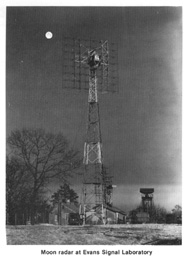
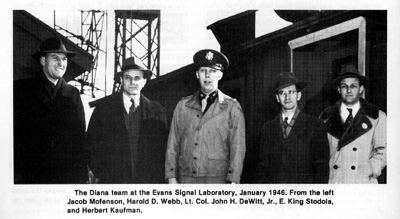
For the antenna they combined two Army SCR-270 radar antennas making a "billboard" array of 64 half-wavelength dipoles measuring 12 by 12 meters and mounted it on a 30 meter tower at the edge of a bluff overlooking the Atlantic Ocean near the Shark River inlet on the Evans Laboratory grounds. This array should increase the power radiated toward the moon by a factor of 64 giving the same effect as 192 kilowatts in a single dipole. They connected a switch to the antenna so that after a pulse had been sent, it could be thrown to connect the antenna to the receiver.
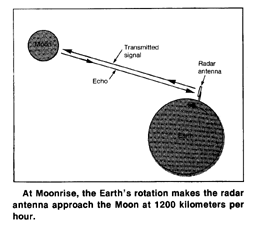 For weeks Jack and his group sent pulses and listened but there was no echo. They did not listen at the same wavelength as they transmitted because at moonrise they were approaching the moon by as much as 1200 kilometers per hour due to the earth's rotation. Therefore, they tuned the receiver to a somewhat higher frequency to compensate for the doppler shift. This is the same effect as the increase in pitch of the horn of an approaching vehicle. They were plagued with equipment troubles but finally about noon on Thursday the tenth of January, 1946, as the moon was rising over the Atlantic they detected their first echo! They heard it 2 1/2 seconds after the transmitted pulse and it showed up as a distinct bump or "pip" on a cathode-ray tube screen. After a few seconds they sent another pulse. Two and one-half seconds later its echo came back. More pulses, more echoes. There was cheering and backslapping but word of their success did not reach the public until in March when Jack announced it at a National Convention of the Institute of Radio Engineers in New York City.
For weeks Jack and his group sent pulses and listened but there was no echo. They did not listen at the same wavelength as they transmitted because at moonrise they were approaching the moon by as much as 1200 kilometers per hour due to the earth's rotation. Therefore, they tuned the receiver to a somewhat higher frequency to compensate for the doppler shift. This is the same effect as the increase in pitch of the horn of an approaching vehicle. They were plagued with equipment troubles but finally about noon on Thursday the tenth of January, 1946, as the moon was rising over the Atlantic they detected their first echo! They heard it 2 1/2 seconds after the transmitted pulse and it showed up as a distinct bump or "pip" on a cathode-ray tube screen. After a few seconds they sent another pulse. Two and one-half seconds later its echo came back. More pulses, more echoes. There was cheering and backslapping but word of their success did not reach the public until in March when Jack announced it at a National Convention of the Institute of Radio Engineers in New York City.
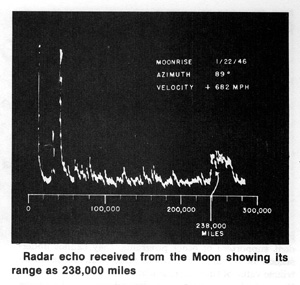 For the first time mankind had sent something of its own making to another celestial body and received it back. Man had reached out with radio waves and Diana had waved back. Twenty-three years later man would leave his footprints. No longer could the goddess Diana or the rest of the cosmos remain aloof to mankind.
For the first time mankind had sent something of its own making to another celestial body and received it back. Man had reached out with radio waves and Diana had waved back. Twenty-three years later man would leave his footprints. No longer could the goddess Diana or the rest of the cosmos remain aloof to mankind.
Project Diana marked the beginning of the exploration of the solar system by radar and of also inadvertently perhaps informing any intelligent creatures beyond of our presence since the strong beams of radars have the best chance of traveling furthest.
But radar has its limitations as can be realized from a consideration of the time delays involved. The moon is 1 1/4 seconds wave travel time distant (1 1/4 light-seconds) so the echo time is 2 1/2 seconds. Depending on its position in its orbit, Mars is 3 to 21 minutes wave travel time distant (3 to 21 light-minutes) so echoes may take 6 to 42 minutes. Pluto, the most distant planet in the solar system, is 5 1/2 hours wave travel time distant (5 1/2 light-hours) and an echo would take 11 hours. Although radar echoes have been received from Mars, Pluto is yet a bit beyond the capability of presently available equipment.
But consider the problem of obtaining a radar echo from the nearest stars at distances of 4 light-years or more. The echo time delay is 8 years, but worse, a transmitter would be required with a power of 10,000 million million times that of a Mars radar!
Thus, earth-based radar exploration beyond the solar system is far beyond our present technology, but it is not beyond thinking and planning. Thus, a Project Cyclops antenna, proposed for a search for extraterrestrial intelligent signals, might do the job.
|
De Witt's Dream
"It has occurred to me that it might be possible to reflect ultra-short waves from the moon. If this could be done it would open up wide possibilities for the study of the upper atmosphere. So far as I know no one has ever sent waves off the earth and measured their return through the entire
atmosphere of the earth.
"In addition, this may open up a new method of world communication.
"The moon is visible several hours out of every 24-hour period in the year. There are many times when communication by this method might be extremely valuable such as during magnetic storms and daytime radio "blackouts". This may provide a means in the future of bringing television programs over long distances, such as across the oceans.
"A frequency well above any frequency reflected by the ionosphere will have to be used. It seems probable that a frequency above 40 megacycles might work."
The discussion continues with calculations of what would be required in the way of equipment to obtain moon echoes.
When John H. "Jack" DeWitt wrote these statements in his notebook on May 21, 1940, they were visionary for no one had bounced radio waves off the moon. DeWitt was still Chief Engineer of WSM at the time. Yet six years later he achieved his dream. Eventually, moon-bounce became commonplace and many of the applications DeWitt anticipated in his 1940 notebook became routine.
|
|
|
Confronting Political Realities
The Federal Funding Process: A SETI Case History
By: Marcia S. Smith
 SETI* (*SETI: Search for Extra-Terrestrial Intelligence) enthusiasts often wonder why the U.S. government isn't pursuing a vigorous SETI program. Like ardent supporters of other programs, they cannot understand how Washington decision makers cannot see the intrinsic value of their program, and why it does not win in the annual competition for Federal monies. Decisions made in Washington may seem mysterious and unfair to those in the outside world, when in fact the process is relatively simple whether in Congress or the Executive Branch: whatever sells at election time is likely to win support during budget deliberations.
SETI* (*SETI: Search for Extra-Terrestrial Intelligence) enthusiasts often wonder why the U.S. government isn't pursuing a vigorous SETI program. Like ardent supporters of other programs, they cannot understand how Washington decision makers cannot see the intrinsic value of their program, and why it does not win in the annual competition for Federal monies. Decisions made in Washington may seem mysterious and unfair to those in the outside world, when in fact the process is relatively simple whether in Congress or the Executive Branch: whatever sells at election time is likely to win support during budget deliberations.
Science Is Hard to Sell
Although the argument can be (and often is) made that science, research and development are the root of most improvements and creature comforts in this land and a cause for our high standard of living, the American taxpayer seems more willing to support and ready to understand expenditures for social and defense programs. The National Science Foundation, National Aeronautics and Space Administration (NASA), and other science research and development related Federal agencies are seen as consumers of huge amounts of money for which the taxpayer receives little visible return. Very few people are aware of the relative budgets of agencies like NASA and the former Department of Health, Education and Welfare (HEW, now split into the Department of Health and Human Services and the Department of Education). An informal sampling of people entering the National Air and Space Museum in Washington several years ago reportedly revealed that 40% of the people questioned thought NASA's budget was larger than HEW's. In fact, HEW's averaged 40 times larger than NASA's (approximately $200 billion versus $5 billion).
Science as a field has had a tough time in Washington politics for decades. As long ago as 1892, funding for paleontology (the science of past animal and plant life) was vehemently opposed during Congressional consideration of a request. In the Congressional Record of May 18, 1892, Congressman Hilary A. Herbert asked, "What practical use has the Federal government for paleontology? What function of the Government is carried on by means of paleontology? Not only has the Government no use for it as a government, but paleontological work is not even necessary to the proper construction of a geological map." Although times have changed since those remarks were made,* (*Note that all our energy sources in the form of coal or petroleum come from past plant and animal life of the earth. —Eds.) especially in the number and kinds of areas which the Federal Government supports, attitudes towards science have not changed as much as one might expect.
Public Opinion Can Influence Votes
Since public support is so important to Washington officials at election time, it is also a critical factor when funding decisions are made in both the Executive and Legislative Branches. The inclusion of the Executive Branch is important here, because all too often Congress alone is blamed for funding decisions, with little realization that Congress is only the last step in many steps of a long time-consuming process that also involves Federal agencies like NASA, and the President and his advisers within the Executive Office of the President, including the Office of Mangement and Budget (OMB) and the Office of Science and Technology Policy. Influencing these decision makers are lobbying groups, one of which is the public itself. Contrary to popular belief, public opinion is quite important in Washington, both at the White House and in the halls of Congress, and letters from constituents can influence votes. For example, in 1971, Senator Clinton Anderson, then chairman of the Senate Committee on Aeronautical and Space Sciences, surprised supporters of the Super-Sonic Transport (SST) by voting against that program when he had been known as an SST advocate. His explanation was simply that he read his mail. Before the vote, mail from his constituents had opposed the SST by a 78 to 8 margin. The public, when properly galvanized, can be as effective as any of the better known lobbying groups like the oil companies and labor unions.
SETI enthusiasts often cite the tremendous public appeal of SETI, noting the positive response by audiences listening to presentations on the subject or by "the man on the street." But the same person who sincerely applauds a speech advocating a government funded SETI program may change his mind at tax time. There was little evidence of public support at the time NASA was trying to get funding for SETI in fiscal year 1979 (FY'79).
In jockeying for priority, public support can be important. In the public sphere, priority making is often expressed by the well-worn question "would you spend $1 of your tax money to support... " in this case a SETI program. While a person might readily answer yes to that particular question, the answer might change if it is phrased "Would you rather spend $1 on SETI or on a government funded program to insure that people on fixed incomes don't have their heat turned off in the middle of winter for non-payment of utility bills." Agency heads have a similar problem, and an administrator who publicly supports a specific program like SETI may still decide against recommending funding for that program when asked to choose between it and, for example, a mission to continue the exploration of Jupiter. That administrator needs to balance the needs of the community he represents, the requirements of his agency as a whole, and the desires of the President he serves.
The Steps to Become a Line Item
A look at what SETI went through in order to become a line item request in NASA's FY'79 budget and its subsequent denial by Congress may elucidate the matter of priorities and budget making. The first step in securing funding for a NASA program is to convince the appropriate headquarters staff of the program's value. Whatever person or group of persons within or external to NASA is pushing the program must lobby for it, including preparation of detailed program justifications for headquarters consideration.
According to Dr. Noel W. Hinners, NASA's Associate Administrator for space science from 1974-1979, this was the first serious problem SETI faced. The Ames Research Center and the Jet Propulsion Laboratory (JPL) people, who wanted the program, submitted separate programs rather than a combined one. For more than a year, proposals were submitted to headquarters and sent back to the centers for refinement before Hinners felt that acceptable program plans were in hand for him to argue on
SETI's behalf. An additional problem was the fact that SETI did not have a "home" at headquarters for its first several years. Funding for the program came from the Office of Aeronautics and Space Technology (OAST), the Office of Space Tracking and Data Systems (OSTDS) (then the Office of Tracking and Data Acquisition), as well as from Hinners' Office of Space Science (OSS). Thus the program had no consolidated support at either the center or headquarters level for several years.
By the time funding decisions were being made for FY'79, SETI had at least found support in the Office of Space Science. Still, there were competing programs from Ames and JPL to deal with, and Hinners made his first priority decision by choosing to support the JPL sponsored all-sky survey approach over the Ames targeted search (with the intent of phasing in the Ames program in future years). Then, he faced priority making between SETI and other programs in physics and astronomy,
planetary exploration, life sciences, and solar and terrestrial investigations, all which are funded by OSS. In the last analysis, the JPL SETI program succeeded in making it onto the OSS list of FY'79 priorities, and then into the total NASA budget submission, even though it was below the dollar line that separated those programs that would be strongly defended in budget negotiations and those that would be presented as "nice to have but not crucial."
By this time, SETI had passed its major milestones at the agency level and now faced the most critical test in the Executive Branch. The Office of Management and Budget (OMB) can make or break a program, and directly reflects the views of the President. Input to OMB decisions on the NASA budget come from NASA itself, the Office of Science and Technology Policy (OSTP), the President and his inner circle of advisers. Much to the surprise of Dr. Hinners, SETI returned from OMB deliberations having been raised into the first group of priorities. Hinners says that he still isn't absolutely certain how this happened, but suspects that a recommendation by OSTP and a sympathetic OMB budget analyst were primarily responsible. Concurrently, in response to the NASA reclama* (*A reclama is a rebuttal to changes that have been made in a budget request.) on the initial budget mark, OMB gave OSS $30 million to allocate among a list of activities which had been budgeted at $36 million. From this amount, Hinners earmarked $600,000 for beginning a seven year SETI program, with a total cost of $16 million, and SETI became a specific line-item request in the FY'79 budget. The actual FY'79 SETI request was $2 million because at the same time, the Office of Space Tracking and Data Systems (OSTDS) approved a plan to request $1.4 million in FY'79 for an all-sky survey. This money was not a line-item request for SETI, however ($500,000 was from the Deep Space Network (DSN) operations budget with the remainder coming from the DSN system implementation budget).
The decision to identify SETI as a line-item request in the OSS section, rather than continuing to fund it through general categories such as supporting research and technology or advanced programs (as was done in the OSTDS request) may have been the critical mistake that led to SETI's downfall. The reason: the ever-present issue of public support, or in this case, lack thereof. Had the agency kept SETI "hidden" in the depths of a general budget category, it would not have been subjected to the scrutiny that a line-item request receives. Hinners explained that his decision was based on the belief that SETI had merit as a bona fide program and he did not want to have to conduct it secretively, and that it should receive public scrutiny.
| DSN: | Deep Space Network |
| FY: | Fiscal Year |
| HEW: | Health, Education and Welfare, Department of |
| HUD: | Housing and Urban Development, Department of |
| JOP: | Jupiter Orbiter Probe |
| JPL: | Jet Propulsion Laboratory |
| NAS: | National Academy of Science |
| NASA: | National Aeronautics and Space Administration |
| OAST: | Office of Aeronautics and Space Technology |
| OMB: | Office of Management and Budget |
| OSS: | Office of Space Science |
| OSTDS: | Office of Space Tracking and Data Systems |
| OSTP: | Office of Science Technology Policy |
| SETI: | Search for Extra-Terrestrial Intelligence |
| SSB: | Space Science Board |
| SST: | Super-Sonic Transport |
Scientists Are Novices at Influencing Legislation
With the decision to publicize SETI, NASA needed support for the program from the public. This support did not materialize. Nor was there much support from the scientific community. Although scientists are still novices at attempting to influence legislation, they had achieved some success during deliberations over the Space Telescope. For that program, a National Academy of Sciences (NAS) report existed which supported the Space Telescope, and the forces of other scientific groups were marshalled to lobby on the project's behalf.
For SETI, alas, there was no NAS support to fall back on. Such a report might have helped congressional SETI supporters influence fellow members to vote in favor of the program, and its absence hurt SETI's chances. When asked why the NAS Space Science Board (SSB) had not performed such a study, SSB chairman A.G.W. Cameron stated simply that NASA had never asked them to. When asked why he had never requested an NAS SETI study, Dr. Hinners replied that the SETI funding request was so
small that he didn't think such a study was necessary. (Following SETI's defeat, Hinners and Cameron agreed that an NAS study might be valuable and the study is now being conducted by the SSB and as part of the NAS Astronomy Survey Committee activity.) Also to SETI's detriment, there was no overwhelming support of SETI in the scientific community. Many radio astronomers, for example, are concerned that a SETI program could take money away from other radio astronomy projects they consider more important.
Without public support, scientific support, or even an NAS study calling for a SETI program, the decision to publicize SETI was premature. This was unquestionably the cause of SETI's downfall. Unfortunately, Senator William Proxmire's presentation of the "Golden Fleece of the Month" award to NASA for the SETI request is often mistakenly thought to have cost NASA, and the Nation, the SETI program. In fact, the actions of one Senator, by himself, do not chart the course of a funding request. Although Senator Proxmire has supporters in Congress, he also has opponents. Those who have watched the actions of the Senate Appropriations Subcommittee on HUD-Independent Agencies (including NASA) which he chairs know that despite his outspoken views against most aspects of the space program, the subcommittee regularly supports NASA funding requests. The space shuttle is a good example of this, since Senator Proxmire has opposed the shuttle since its earliest days, yet his sub-committee and Congress as a whole have supported it. SETI was not NASA's first Golden Fleece award either — in 1976 the agency won that prize for requesting funds to build an addition to the Lunar Curatorial Facility at Johnson Space Center. Despite receiving the award, Congress approved construction of the addition (after denying funding for the project the year before).
The Golden Fleece award may have brought SETI into the public eye, but did not decide its fate in Congress. Four committees and 535 Members of Congress considered the SETI request. The two committees that authorize NASA programs (House Science and Technology and Senate Commerce, Science and Transportation) voted to approve the program, but an authorization only gives an agency congressional permission to proceed, and sets an upper limit on how much funding can be provided. The actual money decisions are the province of the House and Senate Appropriations Committees, and
both of them voted against SETI. The fact that the House Appropriations Committee cut only the $1.4 million from the OSTDS budget and not the $600,000 from OSS was seen by some SETI advocates as opposition to the JPL sponsored SETI program (which the OSTDS money would have directly funded) while supporting the Ames approach, which would have benefited to some extent from the OSS request. In truth, according to House committee staffers, it was a simple matter of not being able to find the full $2 million SETI request in the three-volume NASA budget request. The Senate committee found it all, however, and the two committees agreed to deny all the money.
This was not necessarily the end of the debate, however. Even though a committee or committees may recommend rejection of a funding request, that recommendation must still be voted on by all members of the House and Senate. Congress-watchers who recall the FY'78 debate over funding for the Jupiter Orbiter-Probe (JOP) program will remember that although the House Appropriations Committee recommended no funding for the project, the full House reversed that decision and voted in favor of JOP. Even at the point that the Golden Fleece Award had been presented and both appropriations committees had recommended denial of SETI funding, the members of the House and Senate could have approved it.
That they did not, supports the conclusion stated earlier that SETI's problems were the result of premature exposure of SETI to intense public and political scrutiny without adequate public and scientific support. It also raises the question of how hard NASA itself fought for the program once it knew SETI was in trouble on Capitol Hill. NASA has its own unsung cadre of legislative lobbyists who barter with Congress to make the best possible deal for the agency. In recent years this has been a grueling experience where once again the key word is "priorities." The NASA legislative affairs staff takes its cue from the NASA Administrator, and when forced to make the decision between SETI and programs like the Solar Polar mission and the shuttle, SETI could not compete. With committee recommendations against the project and no strong counter-effort by NASA, the public, or scientific groups, SETI was rejected.
SETI's Future
This does not mean that SETI will never be funded as a line-item program in the NASA budget. If the NAS studies conclude in favor of SETI, and SETI advocates can garner support from a broad constituency, SETI might succeed. The two NASA centers that were previously competing for SETI jurisdiction (Ames and JPL) have reportedly reached agreement on cooperation, a good first step. SETI, like all other science programs, and particularly NASA's space science efforts, will still have an uphill battle to wage for funding both within NASA, the rest of the Executive Branch, and Congress, but when funding demands for the space shuttle diminish, its chances may improve. If SETI truly does have great public support, as SETI enthusiasts claim, and SETI advocates are willing to learn from past mistakes and use the tactics of other successful groups in fighting for their
programs, there would be good reason to believe that SETI might make it in the 1980s.


The author wishes to thank Dr. Noel W. Hinners, now Director of the Smithsonian's National Air and Space Museum, for his reminiscences about SETI funding decisions made during his
tenure as NASA's Associate Administrator for Space Science.
The views and opinions reflected in this article are those of the author and not necessarily those of the Congressional Research Service or any Member of Congress, committee of Congress, or staff thereof.
 Since 1975, Marcia S. Smith has been an analyst in aerospace and energy technology for the Science Policy Research Division of the Congressional Research Service (CRS), the non-partisan research branch of the United States Congress. At CRS, Ms. Smith acts as a consultant to Members and Committees of Congress on issues concerning the space programs of the United States and other countries, and nuclear energy. Previously, she served as administrative assistant at the Washington Office of the American Institute of Aeronautics and Astronautics and correspondent for the Institute's magazine Astronautics and Aeronautics.
Since 1975, Marcia S. Smith has been an analyst in aerospace and energy technology for the Science Policy Research Division of the Congressional Research Service (CRS), the non-partisan research branch of the United States Congress. At CRS, Ms. Smith acts as a consultant to Members and Committees of Congress on issues concerning the space programs of the United States and other countries, and nuclear energy. Previously, she served as administrative assistant at the Washington Office of the American Institute of Aeronautics and Astronautics and correspondent for the Institute's magazine Astronautics and Aeronautics.
Ms. Smith was a consultant to the 1975-76 NASA SETI workshops chaired by Dr. Philip Morrison. She is the author of over 25 reports and articles on the space program, including Possibility of Intelligent Life Elseware in the Universe, written for and published by the Committee on Science and Technology of the House of Representatives. She received her Bachelor's degree from Syracuse University in 1972, and is a member of numerous scientific societies including the American Institute of Aeronautics and Astronautics, and the British Interplanetary Society.
|
|
Off the Shelf
By: Mirjana Gearhart
Space, the Future, and the Search for Intelligent Life beyond the Earth have always fascinated Man, as can be seen by the thousands upon thousands of books and articles written since the days of ancient Greece. In this, and future issues of COSMIC SEARCH, selected books and other publications are presented for interested readers. Space prevents inclusion of more than a few in each issue, but we believe that in these references, both old and new, you will find much that will add to your knowledge, understanding and enjoyment.
Hanbury Brown, MAN AND THE STARS, 1979, Oxford University Press, Oxford, England (180 pgs., hardbound). A lively look at Man's preoccupation with the heavens and the stars.
Robert Burnham, Jr., BURNHAM'S CELESTIAL HANDBOOK, VOLUMES 1, 2, and 3, 1975, Dover Publications, Inc., New York, New York (2138 pgs., paperbound). From the constellation Andromeda to Velpecula, the Burnham handbooks provide the amateur and professional astronomer with detailed observing notes on the constellations.
E. Edelson, WHO GOES THERE? THE SEARCH FOR INTELLIGENT LIFE IN THE UNIVERSE, 1979, Doubleday and Company, Garden City, New York (127 pgs., hardbound). Another look at the various searches for life beyond the Solar System.
Richard P. Hallion and Tom D. Crouch, eds., APOLLO: TEN YEARS SINCE TRANQUILITY BASE, 1979, Smithsonian Institution Press, Washington, D.C. (174 pgs., paperbound). A retrospective look at the dynamics and logistics of committing a nation's resources to getting men on the moon in less than a decade.
Fred Hapgood, SPACE SHOTS: AN ALBUM OF THE UNIVERSE, 1979, Times Books, New York, N.Y. (78 pgs., paperbound). A breathtaking camera's eye view of sites seen by men in space as well as by satellites and exploratory probes.
Garrett Hardin, NATURE AND MAN'S FATE, 1961, Mentor Books, New York, N.Y. (320 pgs., paperbound). A biologist presents a comprehensive study of heredity, evolution and how they will affect man's future on earth.
Robert Jastrow, RED GIANTS AND WHITE DWARFS: MAN'S DESCENT FROM THE STARS, 1979, W.W. Norton and Company, New York, N.Y. (266 pgs., hardbound). A physicist discusses the origin of the Universe.
Glenn G. Strickland, GENESIS REVISITED, 1979, Dial Press, New York, N.Y. (178 pgs., hardbound). The story of how life on earth began. This text is well-referenced and easy to read.
Robert M. Wald, SPACE, TIME AND GRAVITY, 1977, University of Chicago Press, Chicago, Illinois (131 pgs., hardbound). A brief introduction to the concepts of geometry of time and space and both general and special relativity. This is a good basic book for those not interested in a rigorous treatment of such difficult concepts.
C.C. Wunder, LIFE INTO SPACE: AN INTRODUCTION TO SPACE BIOLOGY, 1967, F.A. Davis Publishing Company, Philadelphia, Pa. (296 pgs., hardbound). A book detailing the existence of life in space — its chemical and biological origins and some of the implications life in space may have for life here on Earth.
Louise B. Young, EARTH'S AURA, 1977, Avon Books, New York, N.Y. (294 pgs., paperbound). A fascinating tour of the atmosphere — from the auroral phenomena to the sirocco winds affecting the Sahara Desert. A definitive volume recreating man's attempts at studying the fragile coccoon of atmosphere that keeps him alive.
|
|
Strategies of Searching for Extraterrestrial Intelligence
A Fundamental Approach to the Basic Problem
By: Nikolai S. Kardashev
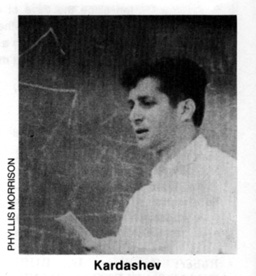 Detection and studies of extraterrestrial civilizations constitute a problem of immense significance for the progress of humanity and for its culture and philosophy. The discovery of intelligent life in the Universe would provide a guideline to the possible development of our civilization over astronomical time spans. Such information could radically change the entire pattern of our life and activity. Interest in this problem is growing from year to year, involving more and more experts in
various natural sciences.
Detection and studies of extraterrestrial civilizations constitute a problem of immense significance for the progress of humanity and for its culture and philosophy. The discovery of intelligent life in the Universe would provide a guideline to the possible development of our civilization over astronomical time spans. Such information could radically change the entire pattern of our life and activity. Interest in this problem is growing from year to year, involving more and more experts in
various natural sciences.
Whom Can We Find?
Proceeding from a basic, reliable observation of astrophysics, that there are fundamental laws which are valid in any observed space and at any period in the evolution of the Universe, we have every reason to believe that all the typical features which we know in the Universe are also known and used by other civilizations. Our civilization is of course still too young to establish contact with others. Since the Solar System belongs to the second stellar generation in the Galaxy and its age is about 5 billion years while the age of the oldest objects in the Universe may be 10 to 20 billion years, it is clear that the lifetime of other civilizations (and in particular, their communicative age) can be incomparably longer than ours. Hence, their knowledge can be much richer than ours, and they must certainly know what we are doing.
Furthermore, because the forms of objects and the idiosyncracies of their evolution are common throughout the observable Universe, it is quite probable that our present state is one through which any civilization should pass during its initial evolution. It may therefore be possible to define civilization on the basis of its universal character as in the functional definition of life on Earth given by A.A. Liapunov as "a highly stable state of matter, which uses information encoded by the states of individual molecules to produce maintaining reactions."
It is highly likely that life becomes possible when a specific type of molecule can be synthesized which is capable of storing and employing the simplest kind of information about the environment and its own structure. This information can later be used to assure survival, reproduction and what is most essential for us, to acquire further information. The regularity is brought about by physical and chemical forces, partially inherent in the molecules, partially dependent on the ambient conditions. In terms of biology, lower forms of life realize this regularity through mutations and natural selection. This same regularity might be regarded as the main stimulus to the evolution of higher forms of civilization.
The way in which higher life forms differ essentially from others is in their capability to abstractly analyze the information acquired. At further stages of the evolution of life, systems of living organisms also come into being, subject to the same kind of regularity. Following the definition of life, given above, I suggest the following functional definition of a civilization at the highest level.
Civilization is a highly stable state of matter capable of acquiring, making abstract analysis of, and utilizing information to obtain qualitatively new information about its environment and about itself, to improve its capabilities of gathering new information for producing sustaining reactions. Civilization is characterized by the content of the information acquired, by the program of functioning, and by the production required to implement these functions.
To specify the method of information coding in this particular case is, in our opinion, quite meaningless since it must account for books, image recording methods, computer memories and possibly artifical life forms which might become available in the future. "Information about the environment and about itself" means data about inorganic and organic nature (including civilizations), science, technology, economy, culture, the arts, etc.
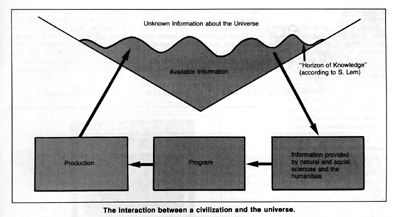
The accompanying figure illustrates the definition given above. It shows the interaction between a civilization and the Universe to which it belongs. To fulfill its desired objectives, the civilization makes use of production and the total sum of acquired learning (which consists of information provided by the natural and social sciences and by the humanities), as well as the program which analyzes that information and produces commands to control the production. This definition of civilization implies that its activity is a means of implementing the functions mentioned in the definition, rather than activity for its own sake.
Another essential question is the concept of a structural and hierarchical character of the information about nature and society. This concept is often presented as an information tree of which only some branches are known to us at present. That is why our definition of civilization emphasizes that evolution requires a continuous flow of qualitatively new information: either higher-order information generalizing well-known laws, or the discovery of new and unfamiliar branches of the information tree. How then, is the longevity of civilizations related to a finite or infinite number of still unknown, fundamental laws of nature?
If all the basic laws are soon discovered, our future will consist only of quantitative evolution. One possible outcome is the extinction of mankind through boredom, degeneration, and loss of interest. However, we do not face such a problem, at least at present. There is an enormous number of basic problems in both the natural and social sciences, which are very far from being solved. The process for their solution will probably generate even more novel and fundamental problems in turn. Here are some examples of outstanding problems in the natural sciences:
- A unified theory of gravitation and relativistic quantum mechanics;
- A theory of elementary particles;
- A theory explaining the numerical values of fundamental physical contants: velocity of light, Planck's constant, constant of gravity, the charge and mass of electrons and protons (or the values of their dimensional combinations);
- The problem of a finite or infinite number of fundamental laws for the microcosm;
- A theory explaining what existed before and at the beginning of the expansion of the Universe, which we are now witnessing;
- A theory explaining the numerical values of the expansion velocity and acceleration of the Universe, as well as its mean density and entropy;
- A theory describing what goes on inside a black hole as seen by an observer falling into it;
- The question of whether cosmic space is simply connected? If not, are there any other worlds, other than the observable micro- and macro-cosms?
- The question of whether the number of fundamental laws of the macrocosm is finite;
- A theory of the origin of life on Earth and the different forms of the origin of life in other parts of the Universe;
- A theory of the brain activity of man and animals.
Thus there is a great variety of important problems whose solution cannot be predicted. We, therefore, draw several conclusions:
First, there is a broad and probably unlimited range of activities required by civilizations for solving problems similar to those mentioned above. Therefore, the period of the evolution and communicative phase of civilizations is long, or possibly even unlimited.
Second, our current level covers only a negligible fraction of that phase. It is therefore highly unlikely that we shall ever meet "brothers in intelligence" who are at our stage of evolution.
Third, highly advanced civilizations know and make wide use of natural laws of which we are still unaware. In my opinion, the latter point should also be taken into account in planning searches for extraterrestrial civilizations.
It is quite probable that our present state is one through which any civilization should pass during its initial evolution.
It is furthermore worthwhile to analyze several hypothetical models of the evolution of civilization:
1. In the paper, "Possibility of the Intelligent Life in the Universe Being Unique," I.S. Shklovsky* (* Astronomy, 5, N1 (1977) ) writes that it is strange that the "blast wave of intelligence" of a supercivilization has not engulfed the whole Universe. If all the above considerations are taken into account, the argument against such a possibility is that it is not so very necessary to expand the occupied space to maintain the activity of the civilization. First, why expand, if everything is the same all over the Universe? Second, in terms of the rate at which the parts of the system exchange information, it is not feasible for them to expand in size. On the contrary, it is more advantageous for two widely separated civilizations to merge, thereby enhancing the information content of each individual civilization while reducing the number of civilizations and the space they occupy.
2. Instead of unrestricted expansion through space, it is possible that the civilizations pursue the following activities, with the aim of acquiring information about new fundamental laws:
- Studies of the microcosm;
- Purpose-oriented space flights to the most interesting objects in our Universe (what about a flight to the center of the Galaxy as a long-term objective?);
- Studies of possible transitions into spaces with dimensions different from ours (through a charged black hole, for example).
High energy is undoubtedly required for such activities of civilizations, and we might expect that the efficiency of its consumption would be sufficiently high. Then according to thermodynamics, the energy consumed will be mainly transformed into radiation with a bolometric intensity approximately equal to that of the background radiation around the source. The spectral distribution of the intensity would be close to that of a black body. This offers one of the possibilities of searching for civilizations. A second premise which could be checked observationally is that large quantities of solid material would be used by a civilization for its astro-engineering activity. The final assumption is that information is sent in the form of electromagnetic radiation.
(To be continued)
|
|
Science Communication in the Mass Media
By: Joan Lurie
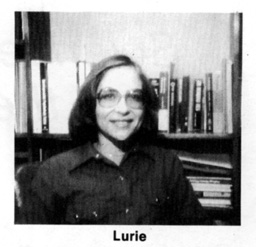
The use of the mass media to present scientific news to the general public was the subject of a symposium entitled "New Initiatives in Science Communications" at a meeting of the American Physical Society in New York City on March 24, 1980. The four panelists included a daily newspaper science writer, the science editor of a weekly news magazine, a physics professor who serves as a consultant for a series of television science programs for children and a physicist who has produced science
"spots" for television network news.
John N. Wilford of the New York Times talked about the goals and degree of success of "Science Times", a weekly section of the New York Times which concentrates on scientific news. The content is determined primarily by the nature of a daily paper; wherever possible the science stories are "news-pegged" i.e. closely tied to breaking stories. The coverage includes biology and medicine, hard science and technology related stories. Biology and medicine, including behavioural sciences, are easier subjects than physics to present to a lay audience. However, according to Mr. Wilford, "If you're not willing to make the effort to get physics stories from physicist to lay audience you shouldn't be in the science reporting business."
The reception of the "Science Times" has been generally positive. Increased circulation of the New York Times at schools and colleges is at least partly attributable to this section. Both content and quality of "Science Times" will be improved as more advertisers are attracted to this section.
Leon Jaroff of Time magazine told the audience that the science journalist in the United States today must be a salesman — he or she has to compete for the attention of editors and audiences with other news that is perceived as more popular. That this salesmanship can result in extremely popular and successful coverage of scientific subjects was amply demonstrated in Mr. Jaroff's amusing, anecdotal talk. He stressed that responsible reporting with substantial scientific content can reach large numbers of people and gave several examples of very successful Time cover stories on scientific subjects.
These included a 1977 story on Leakey's anthropology research and another entitled "The Bugs are Coming" describing research on the use of sex phernomes in the destruction of insects. A more recent success (and a scoop for Time) was this March's story on interferon research.
Time-Life is considering the publication of DISCOVER, a monthly science magazine for the intelligent layman — convincing evidence that the publishing industry believes there is an audience for scientific news stories. This publication would be, in Mr. Jaroff's words, "fairly newsy" with content consisting primarily of stories which occurred in the preceding month. The presentation would be "fairly splashy but responsible". Since reporters for this type of magazine don't have to contend with daily newspaper deadlines, stories could be verified with the researchers.
Both print journalists agreed that science news in the media should include a balance of fast-breaking stories and more reflective pieces. Ideally the wire services should provide more science coverage so that smaller papers without science staff could pick up the stories.
G.F. Wheeler, in a talk entitled "A Physicist in TV Land", described the content and production of "3-2-1 Contact", a science program for eight to twelve year olds produced by Children's Television Workshop. The show has an audience of about two million at home and another two million who watch it at school.
The content of this show is "pre-science" and not science. The speaker described the level of programming as comparable to "pre-English", the preparation for formal training in grammar that children acquire by listening to conversations or watching programs like Sesame Street. The studio portion of the show is narrated by three teenagers with varied ethnic backgrounds in order to provide role models for a wide variety of children. Other portions of the show are shot at locations of interest to children. For example, a tape was shown of a roller coaster design "laboratory" including discussion of roller coaster scale models and forces involved.
The program will run for 13 weeks with each week's 1/2 hour telecasts centered on a theme. The week on "Forces" included episodes on buoyancy, gravity and muscles as well as an introductory program entitled "Forces Change Motion."
One of the most interesting aspects of this talk was the speaker's description of the problems involved in reconciling the world views of the studio people and the science advisors. Typically about five hours worth of footage was shot for every few minutes of the final program with much discussion between writers and scientists as to what was valid scientific and television content.
Since 64 percent of the respondents to a Roper poll named television as their major source of news coverage, television news is, according to David Kalson, the final symposioum [sic; "symposioum" should be "symposium"] speaker, the true mass medium of the late 20th century. In order to reach this large audience (presumably including many people otherwise uninterested in science) the American Institute of Physics produced fifteen 90-second science "spots" for broadcast on regular network news programs. These were funded with the help of a $141,000 grant from the National Science Foundation and were produced under the direction of Audrey Likely. Dr. Kalson coordinated the production and wrote the scripts.
Science Is Part of Everyday Life
The objective of this kind of programming is to enhance public understanding of science; not to teach science but to heighten audience awareness that science and scientific news is a part of everyday life. Three series of five programs each will be produced on Physics and Medicine, Energy in the '80s and Astronomy. Fast-breaking science stories cannot, of course, be covered in this manner and the speaker expects to be "scooped" at least some of the time.
One of the difficulties in achieving effective distribution of this material is the strong resistance of news directors to showing material produced by outside sources. This resistance persists even though the programs are being distributed free of charge. Dr. Kalson stated that even the prestigious, non-profit American Institute of Physics, with its impeccable reputation, ran into this problem. Of the 100 stations which received the material only about 40 made use of it.
The four speakers left the audience with the general impression that, in both the print media and television, a favorable climate exists for more substantive programming and reporting on scientific subjects. However, there is still some resistance on the part of editors and producers so that careful salesmanship and packaging is necessary. When well-edited, newsworthy stories, particularly those showing the human side of science, are presented, audiences will be interested in scientific news.
 Joan Lurie teaches physics and computer programming at Rider College, Lawrenceville, New Jersey, where she has been a faculty member since 1972. Born in Brooklyn, New York, in 1941, she received her Bachelor's degree in physics from Brooklyn College in 1961, Master's degree in physics from Rutgers University in 1962 and Doctor's degree in theoretical solid state physics from Rutgers in 1967.
Joan Lurie teaches physics and computer programming at Rider College, Lawrenceville, New Jersey, where she has been a faculty member since 1972. Born in Brooklyn, New York, in 1941, she received her Bachelor's degree in physics from Brooklyn College in 1961, Master's degree in physics from Rutgers University in 1962 and Doctor's degree in theoretical solid state physics from Rutgers in 1967.
Dr. Lurie held post-doctoral appointments at Rutgers University and University College, London, and also several industrial positions in physics and computer software before coming to Rider College. At Rider, Dr. Lurie is President of the Rider College chapter of the American Association of University Professors. Her present interests include image analysis (pattern recognition) and the use of computer assisted instruction to improve the effectiveness of physics teaching. In a more extra-curricular vein she is Treasurer of the American Physical Society's Committee on the Status of Women in Physics.
|
|
College Courses on "Life in the Universe"
By: Editors
College courses on "Life in the Universe" are becoming increasingly popular. Although dealing mainly with astronomy, many of the courses include much interdisiplinary material from such diverse areas as biology, medicine, psychology, physiology, semantics and communication.
In the last issue of COSMIC SEARCH (Spring 1980) we listed 24 colleges offering or planning to offer courses.
We would like to include additional institutions. Please send information to Prof. John Kraus, Ohio State University Radio Observatory, 2015 Neil Ave., Columbus, Ohio 43210. Years given, attendance, a syllabus (if available) and other information will be appreciated.
Newest listings are:
Institution: Delta College, University Center, Michigan 48710.
Instructor: Dr. Paul A. Catacosinos, Dept. of Geology.
Title: Introduction to Planetology (3 credit hours).
Content: Some astronomy, geology of the solar system, galaxies and planetary origins, life and man's potential role in space (colonies, terraforming, etc.).
Reference: Exploration of the Solar System, W.J. Kaufmann.
Years Given: 1976 to present.
Enrollment: 10 to 25.
Institution: Delta College, University Center, Michigan 48710
Instructor: Dr. Paul A. Catacosinos, Dept. of Geology
Title: Life on Other Worlds??? (1 credit hour).
Content: Life; characteristics and chemistry, origin of life, possible life in the solar system, beyond the solar system, possibility of intelligent life.
References: COSMIC SEARCH, Astronomy, and others.
Years Given: 1978 to present.
Enrollment: 8 to 20.
|
|
The SEnTlnel
By: Robert S. Dixon
Using the Sun to Amplify Radio Waves
When a radio wave passes near a massive object such as a star, its direction of travel is bent slightly toward the star. This bending is caused by the gravitational field of the star. If the radio wave is traveling directly toward the star, then it will be bent around it equally on all sides, and brought to a focus at some point behind the star. The star may be said to act like a lens in this case. If a receiver were located at this focal point, it would receive a highly amplified version of the original wave and hence could detect much weaker and more distant waves.
This amplification effect was originally pointed out by Albert Einstein in 1936, and was recently explored in more detail by Von R. Eshleman of Stanford University.* (*Science, Sept. 1979.) The amount of amplification is directly proportional to both the mass of the star and the frequency of the radio signal. For example, the Sun would give an amplification factor of 10 million at a frequency of 300 gigahertz (1 millimeter wavelength).
Actually, there is no single focal "point." Rather, there is a focal "line" that begins at some minimum distance behind the star, and continues radially outward to infinity. Any point along that line gives the same amplification factor. The minimum distance is inversely proportional to the mass of the object, and directly proportional to the square of its diameter. Unfortunately, this minimum distance is extremely large, which means the receiver would have to be located very remotely. For the Sun, the minimum distance is far outside the solar system, being about 15 times farther out than the planet Pluto. It would take a very long time for us to send a spacecraft out that far. There are two reasons for sending it out even farther. One is that the angular resolution, or ability to distinguish planets and even surface features on the planets where the signal originated, improves in direct proportion to the square root of the distance.
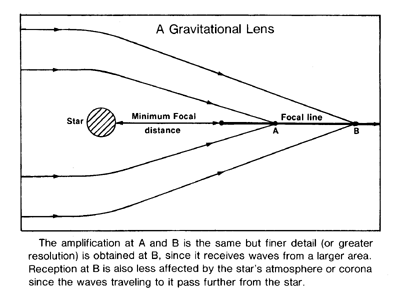 The second reason is related to the solar corona, a layer of hot gas surrounding the Sun that tends to dissipate and counteract the focusing effect of the lens. This effect becomes less serious as the distance increases, but it still prevents the use of frequencies much less than about 300 gigahertz. A distance of four times the minimum, or 56 times Pluto's distance, is required to achieve the theoretical amplification factors.
The second reason is related to the solar corona, a layer of hot gas surrounding the Sun that tends to dissipate and counteract the focusing effect of the lens. This effect becomes less serious as the distance increases, but it still prevents the use of frequencies much less than about 300 gigahertz. A distance of four times the minimum, or 56 times Pluto's distance, is required to achieve the theoretical amplification factors.
The spacecraft carrying the receiver would have to be capable of very precise navigation, because it must be positioned to within 24 meters of the focal line to achieve the maximum amplification factor. Due to the lack of objects to compare positions with beyond Pluto, this navigation task would be most difficult. On the other hand, if a signal were received, it would be readily possible to "home in" on it by adjusting the spacecraft position slightly to achieve maximum signal strength.
The sensitivity of this system is such that the equivalent of Earth's television stations could be received from several thousand nearby stars (although a different spacecraft would be required for each star). The resolution is so great that individual transmitters on the surface of their planets could be selected for reception.
The system could be used equally well for transmitting. If both civilizations could "aim" their gravitational lenses properly at each other, communication would be possible even between distant galaxies.
Assuming that Eshleman's results hold under a wide variety of conditions, it is possible to calculate the amplification factors and minimum distances for different objects that might be used for this purpose. This has been done in the table. From the table we see that the moon is no help at all, and the planets could provide useful amplification but require huge distances (not to mention the fact that their relatively rapid orbital motion would make them almost useless from that far out). The Sun looks hopeful, and black holes even more so, for example, a classical black hole of 3 solar masses. (See next item on black holes.)
Object | Amplification factor
at 300 gigahertz | Minimum
focal distance |
| Moon | 1/2 | Halfway to nearest star |
| Earth | 300 | 500 times Pluto orbit |
| Jupiter | 100,000 | 150 times Pluto orbit |
| Sun | 10,000,000 | 15 times Pluto orbit |
| Smallest classical black hole | 30,000,000 | 5 kilometers |
| Black hole (Earth mass) | 300 | Less than 1 kilometer |
| Black hole (Jupiter mass) | 100,000 | Less than 1 kilometer |
| The amplification and focal length of various objects used as gravitational lenses. |
It would appear that a primordial black hole the mass of a planet like Earth or Jupiter would be ideal, since it would provide useful amplification of 300 to 100,000, but have a shorter, and hence, more convenient focal distance, than the Earth or Jupiter would. If one could be found and brought carefully into the solar system, we could surround it with a spherical swarm of orbiting receivers, and listen to hundreds or thousands of stars all at once.
•
The Two Kinds of Black Holes
Black holes are available in all colors—all of which are black, or so it would seem. Actually, all black holes are really the same but they can be born in two different ways, so we can say that there are two different kinds. This distinction has been lucidly explained by William Kaufmann in the January-February, 1980, issue of Mercury.
"Classical" black holes are the kind we most often hear about. They are created when stars that are at least three times as massive as the Sun collapse in on themselves in their final dying moments. The oldest classical black hole is significantly younger than the universe, since the first stars had not even formed, much less died, until the galaxies first condensed out of the big bang.
"Primordial" black holes were formed in the immediate aftermath of the big bang, as a result of the extreme temperatures and pressures that existed then. Thus, they are as old as the universe. Originally they came in all sizes, with small ones being more common than large ones. However, black holes are believed to evaporate at a rate inversely proportional to their size. The net result of this is that probably all the small primordial black holes (smaller than a small asteroid) have already evaporated. Only the bigger ones are left.
Of the two kinds, primordial black holes seem to be potentially the most useful to man, since they have all the extraordinary properties of all black holes, yet are small enough to be moved where they are needed. Examples of their use would be as an energy source and garbage dump (see the ABC's of Space in the Spring 1980 issue of COSMIC SEARCH), and as a gravitational lens (see preceding item).
•
Metalaw: How to Get Along with an Alien
Sooner or later we may be faced with the problem of dealing with intelligent extraterrestrial beings. In doing so, we will want to choose our actions with utmost care to avoid misunderstandings. Assuming that the "shoot first and ask questions later" segment of our society can be kept under control, most people would probably try some version of the Golden Rule, "Do unto others as you would have them do unto you". One must be careful in applying this rule too literally, however, since the results might be disastrous. Giving oxygen or water to another life form might be lethal to them. Waving or extending a helpful hand might be interpreted as an insult or threat. Clearly the Golden Rule needs some clarification and generalization in this case.
Significant thought has been given to this problem in recent years, and it has been reviewed recently by G. Harry Stine in the February, 1980, issue of Analog. Stine has distilled the suggestions of several earlier authors into "The Principles of Metalaw". They are sumarized as follows:
I. Modified Golden Rule
Do unto others as they would have you do unto them.
II. Free Choice
An intelligent being has the right to free choice of living style, living location and cultural system, so long as this freedom is exercised consistently with the other principles of Metalaw.
III. Free Movement
An intelligent being may move about at will provided he does not breach the Zone of Sensitivity of another intelligent being without permission of that being to do so. (The Zone of Sensitivity varies with the situation. For individual Earthing encounters, it is typically a distance of a meter or so. In other terrestrial cases it is often one's house or property. For a civilization, it might be its planet.)
IV. Survival
An intelligent being may not cause, or, through inaction, allow the destruction of another intelligent being.
V. Self Defense
An intelligent being may suspend adherence to the above Principles if necessary to defend its existence or its rights as stated above.
It is very difficult to create a set of Metalaw Principles that is even completely self-consistent, much less universally applicable. Some of the Ten Commandments appear useful in a more general sense (e.g. "Thou shalt not kill") or on the other hand, some may be less so (e.g. "Thou shalt not commit adultery"). Our first encounter will probably reveal how inadequate Metalaw is, but, nevertheless, it is important to consider such things before the fact, rather than after.
•
An After-the-Fact SETI Program
It is not unusual in astronomy for observations made for one purpose to later become valuable for other purposes. For example, if a star turned into a nova or supernova and became very bright, old photographs of the region containing the star could be examined to find out about the star's past history. Many optical observatories and at least one radio observatory maintain permanent archives of all their observations for this reason.
Recently, Nathaniel Cohen of Cornell University and Matthew Malkan of the California Institute of Technology used this approach and re-examined some radio astronomical observations of globular star clusters made by themselves and others to see if they contained any signals that might have been transmitted by other civilizations.* (* National Astronomy and Ionosphere Center Report No. 111, March, 1979.) The original observations were made to search for long-period variable stars, many of which act as natural stellar masers, emitting narrowband radio radiation at the water line (1.35 centimeter wavelength) and the hydroxyl OH line (18 centimeter wavelength). Since globular clusters are known to contain long-period variable stars, they are a logical choice to search for stellar masers. Globular clusters are large spherical condensations of stars, whose stellar density varies from normal star spacings on the outside to very crowded near the center. Each globular cluster contains about 50,000 stars, and there are about 100 globular clusters in our galaxy.
Since the equipment used to search for natural narrowband radio radiation is nearly the same as would be used to search for intelligent radio radiation, the observations of Cohen and Malkan are particularly appropriate for re-examination with SETI in mind. In addition, globular clusters are not unreasonable places to look for advanced civilizations since their stars are very old (giving plenty of time for evolution and development) and not too far apart (making it easier for neighboring civilizations to discover each other and then realize that there are probably others (like us) out there somewhere). The frequencies searched were those of the water line and OH line, both of which have been suggested as possible frequencies for beacon transmitters.
A total of 25 globular clusters were observed in the data re-examined by Cohen and Malkan. The observations had been made with a variety of equipment at the Haystack Observatory in Massachussetts, at the Arecibo Observatory in Puerto Rico, and at the Parkes Observatory in Australia. Since globular clusters are closely packed, the observations encompassed about 10 million stars. No signals, either natural or artificial, were detected. This enabled Cohen and Malkan to conclude that these wavelengths are not being used for radio transmission by any civilizations of Kardashev Type II or more advanced that might live in the clusters. (Such civilizations would have at least the entire energy of their star available to them). For a few of the clusters, they can conclude that the OH line is not being used for transmission even by any Type I civilization in the cluster. Such civilizations have energy available equivalent to all the sun's radiant energy that falls on the Earth.
Cohen and Malken urge that other astronomical observations made in search of natural narrowband radio signals always be analyzed with the additional possibility of detecting intelligent signals in mind.
•
A New Chain of Life Discovered
Robert D. Ballard and J. Frederick Grassle of Woods Hole Oceanographic Institute recently discovered a living oasis on the floor of the Galapagos Rift in the South Pacific which they called "all but unbelievable." These oases were found along what geologists call spreading centers (places where the rigid plates that form the hard crust of our planet are pulling apart at a rate of a few centimeters per year.)
Writing in the November, 1979, issue of the National Geographic, Ballard and Grassle described a process in which sea water seeps through porous rocks on the ocean floor to unknown depths and then percolates up through warm-water vents, saturated with minerals. By oxidizing solutions of hydrogen sulfide, carbon dioxide and other substances, bacteria multiply in the areas immediately surrounding these warm-water crevices. The bacteria, in turn, become the primary food source for clams, worms, mussels and crabs which also surround these vents. Ballard and Grassle estimate that the concentration of suspended food available at these deep-water cracks is 300 to 500 times greater than just outside vent areas and four times greater than in productive surface waters.
The discovery of an ecosystem based entirely on chemical synthesis overturns the conventional idea that sunlight is always the main source of energy for life, according to the authors. Since oases such as those discovered in the Galapagos Rift are expected to exist all along the Mid-Oceanic Ridge, a totally new, but quite substantial chain of life has been found. The discovery of these oases also illustrates clearly the great adaptability and versatility of life forms. A possible broad implication of this discovery is that extraterrestrial life could exist wherever there is a nearby source of energy of any kind (not just stellar). Such places might include the moons of Jupiter and Saturn, that are heated by tidal forces, and the neighborhoods of black holes.
Contributed by David Raub
•
Computers vs. the Human Brain
The technology explosion has caused computers to increase rapidly in power, while decreasing in size and cost. A report in the March 1980 issue of High Technology summarizes this change and compares it to the computing power of the human brain. As can be seen in the table, the computer has already surpassed the brain in terms of speed and total computing power, and will soon do so in energy efficiency. However, it will apparently be a long time before the brain is equalled in terms of its complexity and compactness.
The implication here is that computers will become ever more important adjuncts to the human brain, taking over more and more of the purely computational functions. But there is no indication that the computer will in the forseeable future be able to replace the brain in other areas, such as judgement, intuition, and creativity.
| Computer Power in Terms of Brain Power |
| | | Year | |
| |
|
|
|
| | 1956 | 1980 | 1990 |
| |
|
|
|
| Speed (switches per second) | 10,000 | 106 | 107 |
| Complexity (total number of switches) | 10-5 | 10-5 | 10-5 |
| Total Computing Power (number of switches per second) | 1/10 | 10 | 100 |
| Energy Efficiency (number of switches per joule) | 10-4 | 1/30 | 10,000 |
| Switch Density (switches per cubic centimeter) | 10-8 | 10-6 | 1/100 |
| Memory Density (bits per cubic centimeter) | 10-15 | 10-13 | 10-10 |
The brain has a value of 1 for all the characteristics listed. If the computer value for a characteristic is greater than 1 then it is more "powerful, in a general sense, than the brain, and if less than 1 less powerful. For example, the top entry in column 2 (1980) is 106 meaning that the computer is now a million times faster than the brain but the 10-6 in the same column for the next to last entry means that the computer now has only one millionth the switch
density (or requires one million times the volume for the same number of switches .)
|
•
Interstellar Bibliography Moved
For a number of years a comprehensive bibliography of books, magazine articles and other published material related to interstellar communications and travel has been prepared and updated by Dr. Robert Forward of the Hughes Aircraft Co. and several of his colleagues. The bibliography and its updates have been published periodically in the Journal of the British Interplanetary Society, with the next update scheduled to appear in the June, 1980, issue.
Recently Dr. Forward and his colleagues announced that after the June update, they would no longer be able to continue their bibliography project. However, arrangements have been made to move the project to The Ohio State University Radio Observatory where it will be continued by David Raub and Robert Dixon. Congratulations are due Forward and his colleagues for initiating and carrying out this project for as long as they have.
Everyone is encouraged to send in lists of additions or corrections to help keep the bibliography as useful as possible. They should be sent to: Robert Dixon, The Ohio State University Radio Observatory, 2015 Neil Ave., Columbus, Ohio 43210.
•
Using the Moon to Look for the Planets of Distant Stars
Present-day large optical telescopes are in principle sufficiently powerful to directly observe the
planets of other stars. However, they are prevented from doing so because they are blinded by the glare of the parent stars. It's a little like trying to see a firefly sitting on the edge of a searchlight many miles away. If the searchlight were turned off, a big telescope could probably see the firefly. But if the searchlight is on, its light swamps out that of the firefly. One way of seeing the firefly even when the searchlight is on might be to position the telescope so that some
large dark object like a building is between it and the searchlight. Then the telescope could be carefully shifted so that the edge of the building just barely covers up the searchlight, but not the firefly. This requires very precise alignment, and is never perfect because some of the light from the searchlight leaks (diffracts) around the corner of the building anyway. Nevertheless, it's a lot better than looking straight into the searchlight.
This same idea has been proposed by James L. Elliot of Cornell University as a means of finding the planets of distant stars.* (* ICARUS, volume 35, p. 156. 1978) He suggests that a dark edge of the Moon be used to cover up (occult) the parent stars, and calculates that planets the size of Jupiter could be detected out to about 30 light years distance with this technique. There are 37 suitable stars within this range. The telescope would have to be located in space, for two reasons. First, to avoid the scattering of light in the Earth's atmosphere that tends to smear out the image seen by telescopes, and second, to enable all the desired stars to be seen, since some stars are never occulted by the Moon as seen from the Earth. A dark edge (not illuminated by the Sun or sunshine reflected from Earth) of the Moon must be used, and the alignment is sufficiently critical that allowance must be made for the individual mountains and valleys on that edge of the Moon.
The telescope has to be in orbit so as to make stable observations, and the orbit must be carefully chosen so that the telescope, Moon and desired star system remain in alignment as long as possible. Elliot has calculated that to do this the telescope must orbit the Earth at a distance varying from 1 1/2 to 2 times the distance of the Moon, with the plane of its orbit tilted relative to the Moon's orbit at a different angle for each different star to be observed. This means that if we could see the telescope from Earth, it would appear to pass either above or below the Moon about once per month. With this orbit, a star can be observed continuously for about two hours with good alignment. The telescope must be positioned to within plus or minus 100 meters, a difficult navigational problem.
The NASA Space Telescope, having a 2.5 meter diameter, is large enough to carry out this project, but it will not be placed in the necessary orbit. It will be in a low Earth orbit, where suitable alignment could only be maintained for 9 seconds. Nevertheless, this would be sufficient to test the validity of the method, and pave the way for a possible future space telescope in the required orbit.
Elliot also points out that his technique could be used to study the planets in our own solar system. The diameters of all the planets, satellites and asteroids could be measured very accurately, and the atmospheres of all the planets could be studied in detail.
•
Earth Life Pushed Back Another 400 Million Years
A rock was found recently in Western Australia by Malcolm Walter of the Australian Bureau of Mineral Resources, that has pushed back the date of the earliest known life on Earth by 400 million years.* (* Reuters, April 2, 1980.) The half meter diameter rock was chemically analyzed and its age established as 3.5 billion years, also a microscopic search revealed the presence of tiny life forms similar to bacteria. Previously the oldest known life forms were 3.1 billion years old.
Walter believes it is unlikely that any life-containing rock older than 3.5 billion years will ever be found, although others of about that same age may yet be found in Australia or South Africa. An even older rock (3.8 billion years) found in Greenland has also been analyzed and found to contain no life forms. If these two ancient rocks from Australia and Greenland are representative of life on Earth, then life must have arisen sometime between 3.8 and 3.5 billion years ago.

|
Miscellaneous Items
Webpage Table of Contents (Bookmarks)
(Internal links to categories of items in this webpage)
Information About the Publication
(Editorial Board, Editors, Table of Contents)

Editors, and Others Involved in the Publication
Editor: John Kraus, Director, Ohio State University Radio Observatory.
Co-Editor: Mirjana R. Gearhart, Research Astronomer, Ohio State University Radio Observatory.
Co-Editor: Robert S. Dixon, Assistant Director, Ohio State University Radio Observatory
Business Manager: Sylvia Raub
Assistants: David Raub, Norman Gearhart, Alice Kraus, Harold DeVries, Ann Cole, Janice Kraus, Richard Arnold, Wendy McKenna, Jerry Ehman, Elsa Damon, Lesly Arnold.
Editorial Board
- Richard Berendzen, President, The American University
- John Billingham, Director SETI Program, NASA-AMES Research Center
- Ronald Bracewell, Director, Radio Astronomy Observatory, Stanford University
- Thomas A. Clark, NASA-Goddard Space Flight Center
- Arthur C. Clarke, Sri Lanka, author of "2001, A Space Odyssey"
- Norman Cousins, Chairman, Editorial Board, SATURDAY REVIEW
- Frank D. Drake, Director, National Astronomy and Ionosphere Center (Arecibo), Cornell University
- Robert E. Edelson, SETI Project Manager, Jet Propulsion Laboratory, California Institute of Technology
- Donald S. Hall, Director, Strasenburgh Planetarium, Rochester, New York; Past President, International Planetarium Society
- Theodore M. Hesburgh, President, University of Notre Dame
- Nikolai Kardashev, Space Research Institute, Academy of Sciences, Moscow, USSR
- Philip Morrison, Physics Department, Massachusetts Institute of Technology
- Bernard Oliver, Vice President, Hewlett-Packard Company; Director of NASA-Ames Cyclops Project
- Cyril Ponnamperuma, Director, Laboratory of Chemical Evolution, University of Maryland
- Martin Rees, Director, Institute of Astronomy, Cambridge University, England
- Carl Sagan, Director, Laboratory for Planetary Studies, Cornell University
- Walter Sullivan, Science Editor, New York Times
- Vasevolod S. Troitsky, Radiophysical Scientific Research Institute, Gorky, USSR
- Sebastian von Hoerner, National Radio Astronomy Observatory
About COSMIC SEARCH
COSMIC SEARCH is published quarterly (Winter: Jan.-Feb.-Mar.;Spring: Apr.-May-June; Summer: July-Aug.-Sept.; Fall: Oct.-Nov.-Dec.) by Cosmic-Quest, Inc. Copyright © 1980 by Cosmic-Quest, Inc. All rights reserved.
Cosmic Quest, Inc., is a non-profit educational-scientific (tax-exempt) organization.
Subscription price: $10 for 4 issues in U.S. (and possessions), $13 elsewhere. Single copies: $2.50 in U.S. (and possessions), $3 elsewhere.
Address subscriptions and all other correspondence to: Radio Observatory, Box 293, Delaware, Ohio 43015.
Second-class postage is paid at Delaware, Ohio, and at additional mailing offices.
Telephone: (614) 486-6587
Opinions expressed by persons writing in COSMIC SEARCH are their own and do not necessarily reflect the opinions of the editorial staff.
Front Cover
Communication satellite in stationary orbit. See "ABCs of Space." Courtesy TRW Corp.
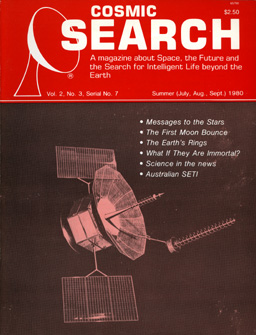
Table of Contents (in magazine)
| Item | Pg |
|---|
Putting Our Best Signal Forward
by Leonard David
Earth's messages to the stars. | 2 |
|---|
A Speculation on the Influence of Biological Immortality on SETI
by Frank D. Drake
What if "they" are immortal? | 9 |
|---|
Diana Waves Back: The First Moon Bounce
by John Kraus
For the first time a radio pulse is sent to the Moon and an echo received back. | 27 |
|---|
Confronting Political Realities
by Marcia S. Smith
The Federal funding process: A SETI case history. | 30 |
|---|
Strategies of Searching for Extra-Terrestrial Intelligence
by Nikolai Kardashev
A fundamental approach to the basic problem. | 36 |
|---|
Science Communication in the Mass Media
by Joan Lurie
Science in the News. | 39 |
|---|
| Features | |
|---|
| More Marconi | 8 |
|---|
| Letters | 12 |
|---|
| Australian SETI | 15 |
|---|
| ABCs of Space | 16 |
|---|
| Coming in COSMIC SEARCH | 34 |
|---|
| Off the Shelf | 35 |
|---|
| College Courses | 40 |
|---|
| Gas is a gas | 41 |
|---|
| Norman Cousins book | 43 |
|---|
| Walter Sullivan receives awards | 43 |
|---|
| The SenTInel (SETI News) | 44 |
|---|
| Advertiser's Index | 48 |
|---|
| In Review Books | |
|---|
| "New Worlds, Discoveries from Our Solar System" by Werner von Braun and Frederick I. Ordway, reviewed by Robert H. Van Horn. | 11 |
|---|
| "The Search for Life in the Universe" by Donald Goldsmith and Tobias Owen, reviewed by Frank D. Drake | 42 |
|---|
| "Fountains of Paradise" by Arthur C. Clarke, reviewed by Mirjana Gearhart. | 42 |
|---|
Coming in COSMIC SEARCH
- "Universal Chemical Evolution" by Robert H. Rubin
- "Space Travel and Life" by E. J. Opik
- "Gravity Waves for Interstellar Communication, by David H. Douglass
- "Not As We Know It"by Isaac Asimov
- "What Makes Atoms Tick" by Earle Holland
- "The Recognition of Alien Biospheres" by James E. Lovelock
- "Strategies of Searching for Extra-Terrestrial Intelligence" by Nikolai Kardashev (conclusion)
- FORUM "SETI Perspectives". Interview with Patrick Palmer and Lee Rickart
- ABC's of Space
- More SEnTlnel items, news reports, book reviews, college courses and many other
special features.
COSMIC SEARCH AWARDS
For best papers on SETI.
Category 1. Undergraduate students.
Category 2. Graduate students.
Category 3. Anyone else under 30 years of age.
Papers may be on any aspect of the Search for Extra-Terrestrial Intelligence (SETI). Papers must be double-spaced typewritten with one inch margins on 81/2 by 11 inch bond paper and less than 2000 words in length. Any illustrations must be clearly
executed.
Authors of best papers will be given a COSMIC SEARCH AWARD of $100 and the paper will be published in COSMIC SEARCH. Authors should include their full address and telephone number. Authors should enclose a self-addressed stamped
envelope if they wish to have their manuscripts returned.
Manuscripts may be submitted at any time. Their review is a continuous on-going process. Each article received is reviewed by a special committee and if judged worthy, either in its original form or after revisions, will be given a COSMIC SEARCH
AWARD. The opinion of the committee is final.
A contestant may submit and have under review only one manuscript at a time and be eligible for only one COSMIC SEARCH AWARD in one category. However, it is possible for one person to achieve COSMIC SEARCH AWARDS sequentially in each
of the three categories.
Address COSMIC SEARCH AWARD Committee, Radio Observatory, P.O. Box 293, Delaware, Ohio 43015.
Miscellaneous Quotes
The following quotes are not directly associated with any article.
Quote on page 7
Life in Space
The only ones in space
Are the human race.
Is this true?
If there are others, tell me who.
Are there others out there?
If there are, tell me where.
Greg M. Walsh
Age 12
Philadelphia, Pennsylvania
Quote on page 14
Ideas always start very small, in just one human brain.
Arno Penzias
Nobel Laureate
Quotes on page 26
The Bean and Life in Space
It was many years ago that a very dignified and slightly belligerent Senator took himself to the Senators' Dining Room to order bean soup, only to discover that there was no bean soup on the menu.
This dereliction on the part of Senate Dining Room cooks called for an immediate declaration of war and the Senator promptly introduced a resolution to the effect that henceforth not a day should pass when the Senate was in session and the restaurant open that there would not be bean soup on the calendar. It has, therefore, become an inviolate practice and a glorious tradition that the humble little bean should always be honored.
There is much to be said for the succulent little bean. In fact, there is much to be said for any kind of a bean, be it kidney, navy, green, wax, Kentucky, chili, baked, pinto, Mexican or any other kind. Not only is it high in nutriment, but in that particular kind of nutritious value referred to as protein — the stuff that imparts energy and drive to the bean eater
and particularly the Senators who need this sustaining force when they prepare for a long speech on the Senate Floor.
I venture the belief that the marathon speakers of the Senate going back as far as the day of the celebrated "Kingfish,"
Senator Huey Pierce Long of Louisiana, and coming down to the modern marathoners in the forensic art such as Senator Strom Thurmond of South Carolina and Senator Wayne Morse of Oregon, both of whom have spoken well in excess of twenty hours and felt no ill effects, would agree the little bean had much to do with this sustained torrent of oratory.
In my enumeration of the bean varieties, I forgot to include one of the most celebrated of all beans, namely, the soybean. Not only has this little Oriental product sustained a civilization in China for perhaps thousands of years, but it has been broken down into so many components that, like Atlas, it fairly carries the weight of the world on its tiny little shoulders.
The soybean today produces soya cake for cattle feed which is highly prized by dairymen and beef producers. Its oils are used for preparing table spreads and cooking oils. It is low in unsaturated fats and is prized by dietitians and that vast host who devote so much of a lifetime to keeping a svelte figure. Its oils are further broken down for use in house paints and the soya cake can now be compressed so hard that it makes door handles and gadgetry without number.
Some day some historical bonepicker seeking a subject for a world-shaking thesis that will live as long as Shakespeare will hit upon the lonely bean. What a welter of knowledge he will develop in his research and I am sure he will come to the conclusion that without the bean, the earth would have long since slipped out of orbit and disappeared among a galaxy inhabited by bean-eaters. Hail to the bean!
Senator Everett M. Dirksen of Illinois
Courtesy Vermont Bean Seed, Co., Manchester Center, VT 05255.
I Wonder Why I Wonder Why
I ventured this night alone
onto December's frozen meadow
where July's cows stood grazing
amid the summer's kindness
just five short months ago.
The night is black
without a moon
so deep
without a moon
and I,
a solitary pinnacle,
painted with starlight
gaze into the deep black night
and dream the untold distances
of cosmic rays in flight
from diffuse galactic nebulas
pinwheels, horse heads, crabs,
so far across the void of space,
so far away in time,
remote beyond the pyramids
and the Nile which gave them birth,
to a time so far beyond
this tiny dust speck Earth.
Ere a creature's single footstep trod
upon the distant beach of life.
Ere a creature such as I
came staring at this boundless sky
with this mind to wonder why
and also wonder
why I wonder why.
Lucian Hunt Turner
Original title "December Night" ©1979
You can only know where you are going if you know where you have been.
James Burke
in "Connections"
Miscellaneous item on page 41
GAS Is a Gas
The "Get Away Special (GAS) Experimenter Handbook" has been prepared by the National Aeronautics and Space Administration (NASA) to encourage the use of space by all researchers, whether organizations or private individuals in order
- to increase knowledge of space
- to foster enthusiasm in the younger generation
- to generate new activities unique to space
- to be alert to possible growth of GAS investigations into a prime experiment.
Investigators will place their experiments in a cylindrical canister about 75 centimeters long by 50 centimeters diameter
and these experiments will be carried into orbit by the Space Shuttle.
An objective of the GAS program is an obvious desire to make space accessible to anyone who wants to do a legitimate, well
thought-out experiment in space where you can get away from gravity.
If you are interested, write to:
Sounding Rocket Division
Goddard Space Flight Center
NASA
Greenbelt, MD 20771
and request a copy of the "Get Away Special Experimenter Handbook." Who knows? Your experiment might be one of those selected to go aboard the Shuttle.
|
![[NAAPO Logo]](../../Images/NAAPOsm.jpg)


